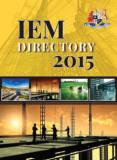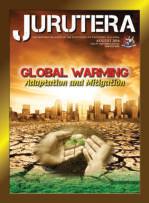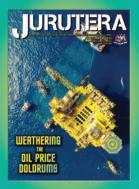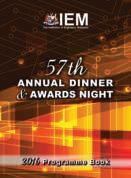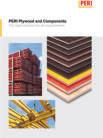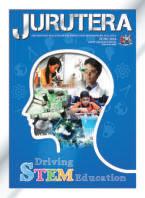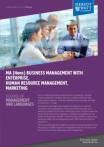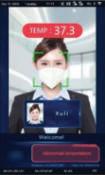




















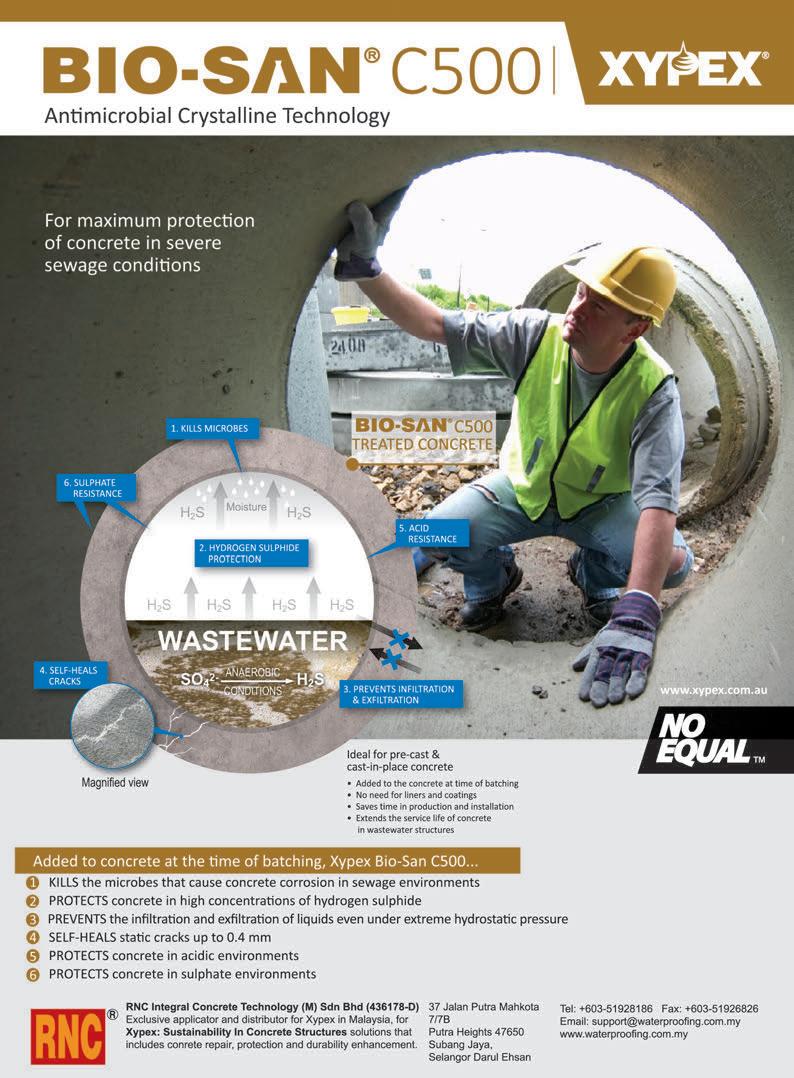
·


Sustainable security is as sure as the sun rising in the morning –Solar power supplies all the energy for day and night operation
Wireless installation provides the flexibility to secure remote areas or temporary sites
An all-inclusive setup light enough for one person to install, but strong enough to withstand heavy rains and fierce weather
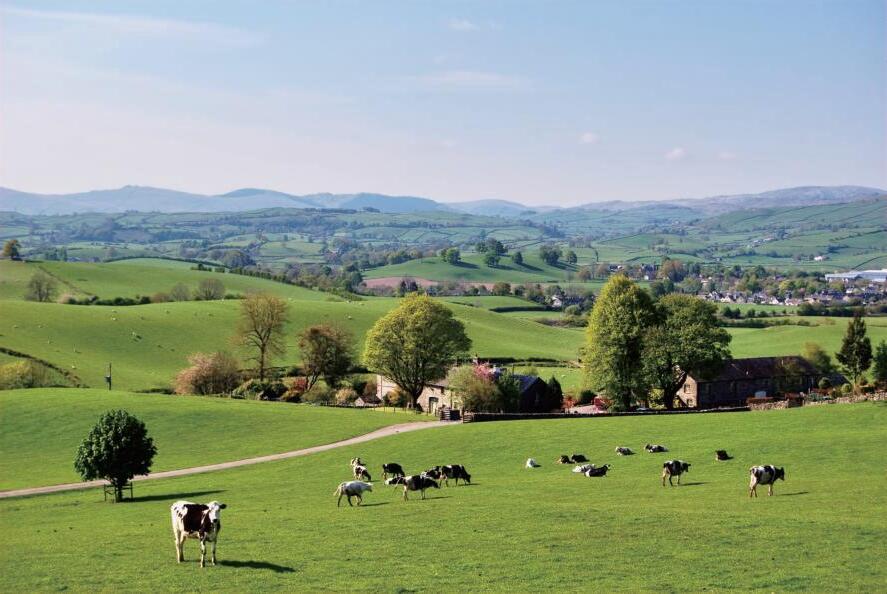
Sales Email: sales.my@hikvision.com


Number 06, JUNE 2021
IEM Registered on 1 May 1959
MAJLIS BAGI SESI 2021/2022 (IEM COUNCIL SESSION 2021/2022)
YANG DIPERTUA / PRESIDENT
Ir. Ong Ching Loon
TIMBALAN YANG DIPERTUA / DEPUTY PRESIDENT
Ir. Prof. Dr Norlida bt Buniyamin
NAIB YANG DIPERTUA / VICE PRESIDENTS
Y.Bhg. Dato’ Ir. Ahmad Murad bin Omar, Ir. Mohd Aman bin Hj. Idris, Ir. Yau Chau Fong, Ir. Chen Harn Shean, Ir. Prof. Dr Leong Wai Yie, Ir. Mohd Khir bin Muhammad, Ir. Prof. Dr Ruslan bin Hassan
SETIAUSAHA KEHORMAT / HONORARY SECRETARY
Ir. Dr David Chuah Joon Huang
BENDAHARI KEHORMAT / HONORARY TREASURER
Ir. Fam Yew Hin
BEKAS YANG DIPERTUA TERAKHIR / IMMEDIATE PAST PRESIDENT Ir. David Lai Kong Phooi
BEKAS YANG DIPERTUA / PAST PRESIDENTS
Y.Bhg. Academician Tan Sri Datuk Ir. (Dr) Hj. Ahmad Zaidee bin Laidin, Ir. Dr Tan Yean Chin, Y.Bhg. Dato’ Paduka Ir. Keizrul bin Abdullah, Y.Bhg. Academician Tan Sri Dato’ Ir. Prof. Dr Chuah Hean Teik, Y.Bhg. Dato’ Ir. Lim Chow Hock
WAKIL AWAM / CIVIL REPRESENTATIVE
Ir. Yap Soon Hoe
WAKIL MEKANIKAL / MECHANICAL REPRESENTATIVE
Ir. Dr Aidil bin Chee Tahir
WAKIL ELEKTRIK / ELECTRICAL REPRESENTATIVE
Ir. Francis Xavier Jacob
WAKIL STRUKTUR / STRUCTURAL REPRESENTATIVE
Ir. Gunasagaran Kristnan
WAKIL KIMIA / CHEMICAL REPRESENTATIVE
Ir. Dr Chong Chien Hwa
WAKIL LAIN-LAIN DISPLIN / REPRESENTATIVE TO OTHER DISCIPLINES
Ir. Dr Bhuvendhraa Rudrusamy
WAKIL MULTIMEDIA DAN ICT / ICT AND MULTIMEDIA REPRESENTATIVE
Ir. Jeewa Vengadasalam
WAKIL JURUTERA WANITA / WOMEN ENGINEERS REPRESENTATIVE
Ir. Rusnida bt Talib
WAKIL BAHAGIAN JURUTERA SISWAZAH / YOUNG ENGINEERS SECTION REPRESENTATIVES
Mr. Kuugan Thangarajoo, Mr. Lim Yiren, Mr. Naveen Kumar, Ms. Tan Wen Jia, Ms. Jacquelyne Anne Boudeville
AHLI MAJLIS / COUNCIL MEMBERS
Ir. Dr Tan Kuang Leong, Ir. Mah Siew Kien, Y.Bhg. Dato’ Ir. Mohd Azmi bin Ismail, Ir. Ng Yong Kong, Ir. Dr Mui Kai Yin, Y.Bhg. Dato’ Ir. Noor Azmi bin Jaafar, Ir. Ting Chek Choon, Ir. Sukhairul Nizam bin Abdul Razak, Ir. Lai Sze Ching, Y.Bhg. Dato’ Ir. Dr Ahmad Anuar bin Othman, Ir. Dr Chan Swee Huat, Ir. Ellias bin Saidin, Ir. Mohd Radzi bin Salleh, Dato’ Ir. Hj. Anuar bin Yahya, Ir. Dr Teo Fang Yenn, Ir. Prof. Dr Jeffrey Chiang Choong Luin Ir. Dr Siti Hawa bt. Hamzah, Ir. Dr Tan Chee Fai, Ir. Mah Way Sheng, Ir. Prof. Dr Zuhaina binti Zakaria, Ir. Lee Cheng Pay, Ir. Dr Kannan a/l M. Munisamy, Ir. Dr Siow Chun Lim, Ir. Wong Chee Fui, Ir. Dr Hum Yan Chai, Ir. Tiong Ngo Pu AHLI MAJLIS / COUNCIL MEMBERS BY INVITATION Ir. Yam Teong Sian, Ir. Gopal Narian Kutty, Ir. Sundraraj a/l Krishnasamy PENGERUSI CAWANGAN / BRANCH CHAIRMAN
1. Pulau Pinang: Ir. Bernard Lim Kee Weng
2. Selatan: Ir. Wong Yee Foong
3. Perak: Ir. Loh Ban Ho
4. Kedah-Perlis: Ir. Mohamad Shaiful Asrul bin Ishak
5. Negeri Sembilan: Ir. Chong Chee Yen
6. Kelantan: Ir. Shaipuddin bin Shapii
7. Terengganu: Y.Bhg. Dato’ Ir. Wan Nazri bin Wan Jusoh
8. Melaka: Ir. Puvanasvaran a/l Perumal
9. Sarawak: Y.Bhg. Dato’ Ir. Janang Anak Bongsu
10. Sabah: Ir. Jeffrey Ng Vun Ping
11. Miri: Ir. Wong Siong Ung
12. Pahang: Ir. Ahmad Kamal bin Kunji
AHLI JAWATANKUASA INFORMASI DAN PENERBITAN/ STANDING COMMITTEE ON INFORMATION AND PUBLICATIONS 2021/2022
Pengerusi/Chairman: Ir. Prof. Dr Leong Wai Yie Naib Pengerusi/Vice Chairman: Ir. Prof. Dr Zuhaina binti Zakaria Setiausaha/Secretary: Ir. Dr Hum Yan Chai Ketua Pengarang/Chief Editor: Ir. Dr Leong Wai Yie Pengarang Prinsipal Buletin/ Principle Bulletin Editor: Ir. Prof. Dr Zuhaina binti Zakaria Pengarang Prinsipal Jurnal/Principal Journal Editor: Ir. Prof. Dr Abdul Aziz bin Abdul Samad
Pengerusi Perpustakaan/Library Chairman: Ir. Dr Kannan a/l M.Munisamy
Ahli-Ahli/Committee Members: Ir. Ong Guan Hock, Ir. Yee Thien Seng, Ir. Chin Mee Poon, Ir. Dr Oh Seong Por, Dr Sudharshan N. Raman, Ir. Dr Lai Khin Wee, Ir. Tiong Ngo Pu, Ir. Dr Lee Tin Sin, Ir. Yap Soon Hoe, Ir. Dr Teo Fang Yenn, Ir. Dr Bhuvendhraa Rudrusamy, Ir. Dr David Chuah Joon Huang, Ir. Tiong Ngo Pu, Ir. Lau Tai Onn, Ir. Yee Thien Seng, Ir. CMM Aboobucker, Mr. Muhd Ashiq Marecan bin Hamid Marecan
LEMBAGA PENGARANG/EDITORIAL BOARD 2021/2022 Ketua Pengarang/Chief Editor: Ir. Dr Leong Wai Yie Pengarang Prinsipal Buletin/ Principle Bulletin Editor: Ir. Prof. Dr Zuhaina binti Zakaria Pengarang Prinsipal Jurnal/Principal Journal Editor: Ir. Prof. Dr Abdul Aziz bin Abdul Samad Ahli-ahli/Committee Members: Ir. Lau Tai Onn, Ir. Ong Guan Hock, Ir. Yee Thien Seng, Ir. Dr Oh Seong Por, Dr Sudharshan N. Raman, Ir. Dr Lai Khin Wee Secretariat: Janet Lim, May Lee
THE INSTITUTION OF ENGINEERS, MALAYSIA Bangunan Ingenieur, Lots 60 & 62, Jalan 52/4, P.O. Box 223, (Jalan Sultan), 46720 Petaling Jaya, Selangor Darul Ehsan. Tel: 603-7968 4001/4002 Fax: 603-7957 7678 E-mail: sec@iem.org.my Homepage: http://www.myiem.org.my
COVER NOTE & EDITOR’S NOTE
The Digital Transformation Journey
COVER STORY
Digital Transformation for Engineering in the New Normal
Digital Transformation for an Inclusive & Sustainable Recovery Post Pandemic
Impact of Artificial Intelligence and Digital Transformation in a Post Pandemic World
LENS
Temple of Trees
Introduction to Electrical Design in Building Services IEM UTAR FYP Poster Competition 2021
CESIG Industry4WRD Webinar Series
Workshop on Resume Writing and Job Interviews
Zhaozhou Bridge: 1,400-Year-Old Engineering Marvel


3,200
3,200/page
Full-Page, Full-Colour Advertisement
This one-time-only special rate offer is for new advertisers.
Space availability is subject to booking on a first-come-first-served basis.
Clients will provide ready-to-print artwork in PDF format with 300dpi.
Full page: 210mm x 285mm, 5mm extra bleed sizes for 4-sided with crop mark.
Advertising space must be utilised before 31 December 2021.
*Please note that the above rate will be subjected to 6% SST. For overseas advertisers, an additional 25% will be charged.
Rate shown above excludes 15% advertising agency commission.
Payment term: Full advance payment.
Artwork submission deadline is on (or before) the 1st week of the prior month of publication. After the material deadline, no cancellation or alteration to the advertisement will be entertained.
Any cancellation after signing the advertising order will result in a 50% penalty charge. The publisher reserves the right to edit, revise or reject any advertisement deemed unsuitable or inappropriate. •
JURUTERA has an estimated readership of 200,000 professionals. Our esteemed readership consists of certified engineers, decision making corporate leaders, CEOs, government officials, project directors, entrepreneurs, project consultants, engineering consulting firms and companies involved with engineering products and services. Circulation & Readership Profile
Publicationmonth/s:
DIMENSION PUBLISHING SDN. BHD. [ 199701034233 (449732-T) ]
Level 18-01-02, PJX-HM Shah Tower, No. 16A, Persiaran Barat, 46050 Petaling Jaya, Selangor Darul Ehsan, Malaysia. Tel: +(603) 7493 1049 Fax: +(603) 7493 1047
E-mail: info@dimensionpublishing.com Website: www.dimensionpublishing.com
CHAIRMAN
ROBERT MEBRUER
CEO/PUBLISHER
PATRICK LEUNG
GENERAL MANAGER
SHIRLEY THAM ● shirley@dimensionpublishing.com
HEAD OF MARKETING & BUSINESS DEVELOPMENT
JOSEPH HOW ● joseph@dimensionpublishing.com
PRODUCTION EDITOR
TAN BEE HONG ● bee@dimensionpublishing.com
CONTRIBUTING WRITERS
PUTRI ZANINA ● putri@dimensionpublishing.com
HANNA SHEIKH MOKHTAR ● hanna@dimensionpublishing.com
SENIOR GRAPHIC DESIGNER
SUMATHI MANOKARAN ● sumathi@dimensionpublishing.com
GRAPHIC DESIGNER
SOFIA ● sofia@dimensionpublishing.com
ADVERTISING CONSULTANTS
THAM CHOON KIT ● ckit@dimensionpublishing.com
ACCOUNTS CUM ADMIN EXECUTIVE
YEN YIN ● yenyin@dimensionpublishing.com
For adver�sement placements and subscrip�ons, please contact: DIMENSION PUBLISHING SDN. BHD. [ 199701034233 (449732-T) ]
Level 18-01-02, PJX-HM Shah Tower, No.16A, Persiaran Barat, 46050 Petaling Jaya, Selangor Darul Ehsan, Malaysia. Tel: +(603) 7493 1049 Fax: +(603) 7493 1047 E-mail: info@dimensionpublishing.com
Subscription Department E-mail: info@dimensionpublishing.com
JURUTERA is published and printed monthly by Dimension Publishing Sdn. Bhd.
JURUTERA MONTHLY CIRCULATION: OVER 50,000 MEMBERS Submission or placement of ar�cles in JURUTERA could be made to the:Chief Editor
THE INSTITUTION OF ENGINEERS, MALAYSIA (IEM) Bangunan Ingenieur, Lots 60 & 62, Jalan 52/4, P.O. Box 223 (Jalan Sultan), 46720 Petaling Jaya, Selangor. Tel: +(603) 7968 4001/4002 Fax: +(603) 7957 7678 E-mail: pub@iem.org.my or sec@iem.org.my IEM Website: http://www.myiem.org.my
© 2020, The Ins�tu�on of Engineers, Malaysia (IEM) and Dimension Publishing Sdn. Bhd.
PUBLICATION DISCLAIMER
The publica�on has been compiled by both IEM and Dimension with great care and they disclaim any duty to inves�gate any products, process, services, designs and the like which may be described in this publica�on. The appearance of any informa�on in this publica�on does not necessarily cons�tute endorsement by IEM and Dimension. There is no guarantee that the informa�on in this publica�on is free from errors. IEM and Dimension do not necessarily agree with the statement or the opinion expresssed in this publica�on.
COPYRIGHT
JURUTERA Bulle�n of IEM is the official magazine of The Ins�tu�on of Engineers, Malaysia (IEM) and is published by Dimension Publishing Sdn. Bhd. The Ins�tu�on and the Publisher retain the copyright over all materials published in the magazine. No part of this magazine may be reproduced and transmitted in any form or stored in any retrieval system of any nature without the prior written permission of IEM and the Publisher.
by Ir. Yim Hon Wa Chairman, Consulting Engineering Special Interest Group
Digital Transformation is the adoption of modern digital technology to transform services or businesses by replacing non-digital or manual processes with digital processes or by replacing old technology with new digital technology.

The aspect of digital transformation is the concept of going paperless or reaching “digital business maturity” affecting both individual businesses and segments of society such as government,mass communications, arts, healthcare and science. In political, business, trade, industry and media discourses, digitisation is defined as the technical process of converting analog information into digital form (i.e. numeric,binary format),as the term may also refer to manual information digitisation.Digitalisationistheorganisationprocessorbusinessprocessof technologically-induced change within industries, organisations, markets and branches. Digitalisation of manufacturing industries has enabled new production processes and much of the phenomena today known as Internet ofThings,Industrial Internet,Industry 4.0,machine to machine communication,artificial intelligance and machine vision.
Digital transformation has created unique marketplace challenges and opportunities as organisations must contend with nimble competitors which take advantage of the low barrier to entry that technology provides. In addition,due to the high importance given today to technology and its widespread use, the implications of digitisation for revenues, profits and opportunities have a dramatic upside potential.
by Ir. Prof. Dr Zuhaina binti Zakaria Principle Bulletin Editor
It is an honour and a privilege for me to assume the responsibilities as Editor of JURUTERA. I am grateful to the Standing Committee on Information & Publication for giving me this opportunity.On behalf of the editorial board,I would like tothankmypredecessor,Ir.DrBhuvendhraaRudrusamy,whohad invested significant efforts to advance the profile of this monthly bulletin.Giventhesuccessofthebulletin,thenewEditorialBoard willnotmakeanyimmediateorradicalchanges;however,wewillcontinueto publish relevant and current articles to meet the needs of our readers.

Thismonth, JURUTERA highlightstheimpactoftheCOVID-19pandemicon digital transformation.Since the first Movement Control Order was imposed more than a year ago,COVID-19 cases continue to increase.The pandemic has impacted all aspects of our life and due to the restricted movement, working from home has now become the new standard.
In response, businesses and government offices have had to turn to new technologies in order to continue their operations, albeit remotely in many cases.Although technology has always been an important element in the workforce, the pandemic has accelerated the adoption of digital technologies and the trend is most likely to stay even after the pandemic.



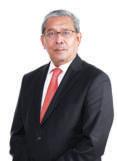
Mr. Arham Abdul Rahman has a distinguished career in MIDA that spans 3 decades. He had served primarily in its foreign investment arm with years of service in Germany and the USA. He also played an active role in drafting and formulating various Malaysian industrial roadmaps and blueprints, including the currently ongoing 12th Malaysia Plan and New Industrial Master Plan. His experience as a MIDA frontliner for 3 decades in various initiatives locally and overseas makes him uniquely qualified to lead MIDA to cement and enhance Malaysia's position as a preferred investment destination for prospective Foreign High-Technology Investors.
QCanMalaysiacapitalise on the rapid and intensive expansion of the adoption of 4IR technologies to gain a competitive advantage in its more lucrative exports industries against regional and global competitors?
Since Malaysia launched the National Policy on Industry 4.0 (Industry4WRD) in 2018, there had been many initiatives by the Government to attract stakeholders, to create the right ecosystem and to transform the country’s industry capabilities towardsIndustry4.0.Whatarethe opportunities and threats for the Government,SocietyandIndustry now?
For the last five decades, the Malaysian Investment Development Authority (MIDA), the Government's principal investment promotion and industrial development agency under the Ministry of International Trade & Industry (MITI),had assumed a critical role in contributing to Malaysia’s rapid industrial progress in the manufacturing and services sectors.MIDAkeepsintensifyingefforts to secure sustainable investments from domestic and foreign sources to strengthen the nation’s economic growth.
Industry 4.0 is already addressing and creating solutions to global resource and energy efficiency, urban production and balancing demographic change. It enables continuous resource productivity and efficiency gains across the entire value network as innovative technology leads to better policymaking, more sustainable business models, new jobs and income opportunities.
In pushing the adoption of Industry 4.0 technology, the Government is investing on infrastructure readiness as industry players undertake the necessary shift in their business processes. In 2019, the National Fiberisation &
Connectivity Plan was formulated in response to the nation’s desire for improved broadband quality and coverage, lower broadband prices and to provide Internet access for all spectrums of society.
In January 2020, the Malaysian Communications & Multimedia Commission (MCMC) identified 700 MHz, 3.5 GHz and 26/28 GHz as the pioneer spectrum bands for the roll-out of 5G. In line with the goal to implement 5G infrastructure nationwide by 2023, MCMC, along with other stakeholders and companies (such as Celcom Axiata, Digi Telecommunications, Edotco Malaysia,Maxis Broadband,Telekom Malaysia,UMobile,PetroliamNasional and YTL Communications) are currently running 5G demonstration projects in 6 states,involving an initial investment of RM143 million.
As the lead agency of MITI in implementing strategies for Industry 4.0,MIDAiscollaboratingwithTMOne for the deployment of high-speed internet connection in industrial areas. TM One, the enterprise and public sector business arm of Telekom Malaysia Berhad (TM), has successfully deployed high speed broadband (HSSB) accessibility to 33 industrial areas in the Northern, Southern and Eastern regions, including Sabah and Sarawak, in February 2021. This would allow industriesandbusinessestoleverage onandkeepupwiththelatestdigital transformation to remain relevant as they rely heavily on internet connectivity to be more productive, efficient and competitive, enabling greater automation and richer insights through big data analytics.
The Government is also aggressively creating awareness of the importance of Industry 4.0 technology adoption and its positive impacts on businesses. The Government has introduced funds to help reduce the financial burden forcompanieswillingtotaketheleap forward and face the challenge of Industry4WRD.There is an undeniable urgency for companies to trust
technologies and to strategically adapt these disruptive technologies to remain relevant and reduce lowskilled labour dependencies.
Future machines will be increasingly highly networked, enabling work without boundaries across the globe.This translates to a knowledge revolution and a skilled workforce will be the norm. Rather than view machines and robots as a threat to job security, society should see these as an opportunity to elevate the current positions through knowledgeupgradingandupskilling.
Hence, there is an urgent need to invest in education and training sectors to ensure there is ample human capital supply that is equipped with the proper knowledge and technical expertise. In addressing digital literacy among Malaysians,aprerequisiteforIndustry 4.0 technology transformation is the importance of technological knowledge penetration through education, starting with secondary level education.
Local training institutes, such as German Malaysia Institute (GMI), Penang Skills Development Centre (PSDC), Kedah Industrial Skills & Management Development Centre (KISMEC) and local universities including Universiti Malaysia Perlis (UniMAP), University Malaya (UM), Universiti Putra Malaysia (UPM) and Universiti Teknologi Malaysia (UTM), have been instrumental in offering Industry 4.0-related programmes.
Malaysia is a popular destination for ICT companies looking at international market expansion and global players IBM, HP, Intel, Huawei, Microsoft and Oracle have already madetheirmovehere.In2019,Oracle launched a Cloud Solution Hub in Kuala Lumpur to help firms integrate Blockchain, Machine Learning, Artificial Intelligence (AI) and Data Analytics. The successful operations were attributed to the enabling and progressiveecosysteminthiscountry. ThepresenceoftheseMNCsopensa gateway for homegrown companies to develop competitive advantage,
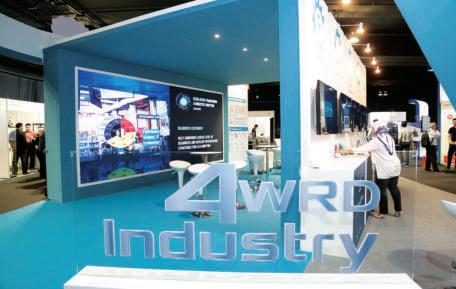
some in complementing services for MNCs through knowledge transfer, joint ventures and collaborations.
Tocompetewithortobeinalliance with these tech giants, Malaysian companies must gain momentum through sizable capital investment. These companies can adopt a consortium approach in bringing local tech expertise together and pool their resources to complement eachother.Thispartnershipcangain a sizeable market share and support competitive advantage.
The Government is also encouraging the utilisation of local services provided by services and manufacturing companies as this will contribute to the domestic growth and reduce the services trade deficit. For instance, MITI has imposed pre-conditions for the issuance of Manufacturing Licences for manufacturing projects to utilise local engineering and architecture services.
To further capitalise on the progressive expansion on the adoption of 4IR technologies, under MyDIGITAL, the Government has set up the national Digital Economy & Fourth Industrial Revolution Council (MED4IR)tomonitorthegrowthofthe digital economy and the harnessing of 4IR technology. It is the highest administrativebodyforimplementing and reviewing the nation’s strategies
andinitiativesforthedigitaleconomy and 4IR.
The Council has also endorsed the establishment of the Digital Investment Office (DIO), a fully collaborative digital platform between MIDA and the Malaysia DigitalEconomyCorporation(MDEC). It aims to create awareness of digital investments in the country and to strengthen coordination among all investment promotion agencies (IPAs) in promoting and attracting new digital investments.
MIDA is committed to working closely with industrial players and stakeholders to ensure the best outcome for the people, businesses and the economy.
QWhat major changes has Malaysia made to its incentives package to attract investments that can accelerate economic growthinthepostpandemicera, especially for industry sectors where local engineering related inputsunder4IRcanbeexploited?
The Government has cultivated an investment-friendly environment with competitive investment incentives to ensure we remain a preferred investment destination amidst the COVID-19 pandemic. Continuous revision and fine-tuning of business
policies are being made to make Malaysia more competitive and attractive.
Since the launch of the National Policy on Industry4WRD, many initiatives have been outlined to drive digital transformation across the manufacturing and related services sectors. In 2020, the Government announced the National Economic Recovery Plan or Pelan Jana SemulaEkonomi Negara (PENJANA), with goals that included protecting jobs and empowering local businesses. Through this initiative,new measures and the enhancement of existing measures for employers/companies and employees/individuals were introduced to support the reopening of the economy under the "new normal”.
Various incentives and grant packages to attract new investments are introduced especially for investments involving the adoption of 4IR, also known as “smart factory” with cutting-edge development in the digitisation and automation of manufacturing processes.
MIDA is managing initiatives of Intervention Fund (IF), Smart Automation Grant (SAG), Domestic Investment Strategic Funds (DISF) and Automation Capital Allowance (Automation CA) in aligning to Industry 4.0 technology adoption. Notably, the announcement of PENJANA allows further enhancements to the DISF and SAG criteria and procedures.
DISF was established to strengthen domestic investment to ensure sustainable economic growth. Funding options are offered to companies for the training of the localworkforce,R&Dactivitiescarried out in Malaysia, modernisation and upgrading of manufacturing or services facilities and tools, obtaining of international standards/ certification and licensing or purchase of new/high technology.
For the services sector, priority sectors include architectural/

SikaWrap System is a unidirectional woven carbon fibre fabric used for strengthening works for
Replacing missing steel reinforcement
Increasing the strength and ductility of columns
Increasing the loading capacity of structural elements
Enabling changes in use / alterations and refurbishment
Correcting structural design and / or construction defects & improving service life and durability
WISH TO KNOW MORE?
Contact our Refurbishment specialist Steven Ng at +012 300 2703 or download SikaWrap-301C product datasheet
engineering services and ICT solution providers which relate to automation and Industry 4.0. MIDA has expanded the scope of the existing DISF which was targeted at the manufacturing sector in the initial years, to further include selected services sub-sectors. Among the eligible services subsectorsaredevelopment,calibration, architectural, ICT solution providers related to automation and Industry 4.0andintegratedgreentechnology projects. Under the National Budget 2019,thefundwasfurtherexpanded to assist companies undergoing the Industry4WRD ReadinessAssessment to migrate into Industry 4.0.
Under the current PENJANA scheme, the enhanced DISF provides an avenue for second round matching grant for eligible companies that had been previously approved for DISF grants. This initiative, expanded until 31 December 2022, also includes industriesintheecosystemofsectors classified as of National Importance, as compared to the existing activities and products promoted under the Promotion of Investments Act, 1986. Other enhancements include increased flexibility on the equity ownership of at least 51 per cent Malaysian-owned and special increased ratio approval of training grants and capital grants for the purpose of Industry 4.0 technology adoption to 70:30, whereby the Government will finance 70% of the approved expenditure while 30% will be covered by the company.
The Smart Automation Grant (SAG), on the other hand, was introduced under PENJANA to help local players adopt new processes to improve operational and manufacturing efficiencies through high technology. The Government initially allocated RM100 million to assist SMEs and Mid-Tier Companies (MTCs) to automate or digitalise operations and trade channels.
Under the scheme, eligible companies will be offered a grant
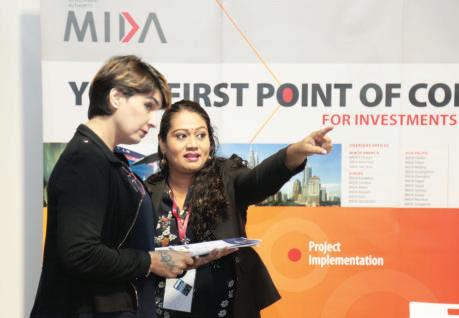
on a matching basis (1:1) based on eligible expenditure, up to a maximum RM1mil per company. Since its launch in December 2020, SAG has received overwhelming response from the industry players. As at March 2021,MIDA has received over 200 applications, which has surpassed the original projection. To address the increase in demand fromtheindustry,MIDAwasapproved additional funding of RM50 million under the PEMERKASA initiatives to support the next phase of economic recovery this year.
Another exciting concept is the Lighthouse Project being championedbyMIDA,inapproaching MNCs and local corporations which have successfully gained from 4IR transformation,totakeuptheinitiative to guide,facilitate and support local manufacturing industries to also ventureintothe4IRprocessestogain business traction. This aligns with the Government’s aspiration for the country to be among the top Global Manufacturing Nations. MIDA seeks to seriously engage and propose to companies that have successfully adoptedtheIndustry4.0keypillarsin their projects in Malaysia.
The foreign and local companies, including MNCs, are encouraged and provided with Government
support to “tailor-made facilities” in establishing linkages and to develop local vendors in leading these local companies to take actionable steps to advance into Industry 4.0.
Initson-goingefforts,MIDAinitiates discussion and webinar sessions with industry players, potential investors, internationalchambersofcommerce and industry and associations.Initial interests have been conveyed by 9 multinational corporations and 10 local companies to explore the Lighthouse initiative.
MIDA is ready to discuss with companiesandindustrystakeholders to provide the best options for their automation and digitisation journey. Local engineering companies such as machinery and equipment producers as well as system integrators can leverage on these opportunities.
MIDA has also developed i-Services Portal, a single market place to link investors/companies interested to source for domestic services, with local service providers. The portal is reachable via http:// iservices.mida.gov.my. It acts as an effective medium for local service providerstoexpandtheirmarketsand further boost their business activities in today’s globalised and rapidly changing business environment.
QHave industry associations (like FMM and MPMA) indicated their needs for transitioning to higher levels of digitisation or automation which can be satisfied through more intensive application of 4IR technologies?
Towhatextentcaninstitutions such as IEM and chambers/ associations help Malaysian industries and investors to make the country at least a regional leader in the adoption of 4IR on anacceleratedbasis?
It is important to highlight that MIDA does not only focus on FDI.Domestic investments play a significant role to ensureMalaysiaremainscompetitive and relevant on our path to recovery amidstthispandemic.Thepandemic has compelled an inevitable shift towards digitalisation and automation. Businesses are under pressure to adapt quickly to this new normal and it has accelerated the need for us to leverage on digital technologies to develop better business practices and approaches.
The implementation of Industry4WRD sees the expansion of MNCs and SMEs in accelerating the Industry 4.0 technology adoption.
Among the factors contributing to this development is the presence of solution providers within the ecosystem and existing industry players which are ready to take on the challenge to adopt Industry 4.0 technology. However, there is still plenty of room for improvement. The Government can connect stakeholders to work together and to share their knowledge and resources through collaborations to complement each other.
As partners to investors, MIDA boasts of having a close working relationship with industry players on the ground.Hence,despite COVID-19 and the restrictions imposed on movementandgatherings,MIDAhas remained resilient and responsive in providing advice and support to existing and potential companies.In 2020,MIDAsuccessfullyheldover500 online engagements with local and foreign stakeholders through various online platforms and digital tools were utilised to ease investors and to sustain confidence in Malaysia during these challenging times.
Dialogues with local industry associations such as FMM, MPMA and NCCIM have witnessed their members highlighting the need to transition.Among the most common area of concerns raised are:
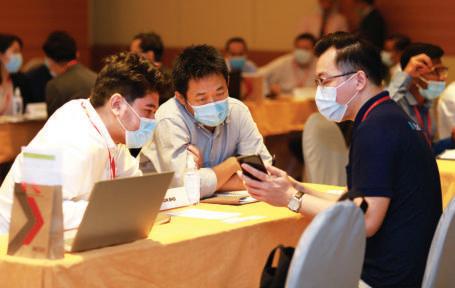
• Readiness of the internet infrastructure for 4IR
• Impact of workers who might lose their jobs after automation
• Best time to promote machine vision automation
• Pandemic impact to accelerate Malaysia's digitalisation transformation,particularly for the SMEs
• Challenges in terms of cost and talent availability.
To address these concerns, MIDA continuestoworkcloselywithindustry players to update on the latest policy changes due to the pandemic as well as available facilities to enable digitisation or automation undertakings to keep pace with the stringentrequirementsanddemands of the pandemic.
MIDA is ever ready to provide the necessary support to improve the adoption of the Industry4WRD initiatives towards enabling the business environment to be more productive, efficient and competitive. We look forward to more exciting ventures and further strategic partnership to take Malaysia to the next level, further leveraging our investment ecosystem and facilities to grow in the region for the future.
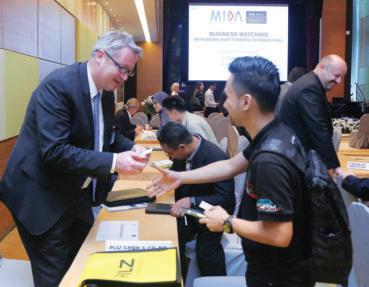

Dato’ Abdul Latif bin Haji Abu Seman is Director-General of Malaysia Productivity Corporation (MPC). Under his stewardship, MPC has successfully collaborated with international government bodies such as the Australian Government Productivity Commission and OECD in establishing Malaysia’s Quality Regulatory Management System and modernising Malaysia business regulations. He also leads the MPC team under the ambit of PEMUDAH to improve Malaysia’s competitiveness and enhancing the Malaysia business climate.

What are the initiatives or steps that Malaysia Productivity Corporation (MPC)istakingtoassistindustries, especially SMEs to face the challengesofdigitaltransformation andstaycompetitiveglobally?
• MPC continues to encourage technology adoption among businesses to improve productivity by
- Acknowledging and collaborating with technology centres and technical experts
- Encouraging businesses for self-assessment on technology adoption and
- Setting out to prove that digital technology is implementable.
• In 2020, MPC introduced the MPC GoDigitalinitiative,whereactivities and services could be conducted online through Business Virtual Advisory Service (BVAS). The objective of Bringing Productivity Activities to Every Business That
ConnectstoTheInternet,benefited 20,000 firms in 2020.
• Below are examples of MPC 2020 programmes.
- Electrical&ElectronicsProductivity Nexus (EEPN) has initiated the Plugfest workshop to accelerate Industry 4.0 among the local industries.
- TheprimaryobjectivesofPlugfest 2.0 are to promote Machine Vision technology based on Artificial Intelligence (AI) and to empower the participants to be able to embed the Machine Vision system in their work environment.
- Forty-five engineers from 25 companies took part in this programme from August to October 2020.
- EEPN is currently devising a plan to proliferate this programme on a larger scale.
- Machinery&EquipmentProductivity Nexus (MEPN) launched PRODUCTIVITY1010 (Productivity through Digitisation) through Business Virtual Mentoring Services (BVAM)on29August2020.
- This programme assists companies to develop individual digitisation roadmaps to start their digitisation journey.
- Developed digitisation selfdiagnostic and prioritisation matrix tools with 6 hours of virtual mentoring sessions, guided by 20 technology expects.
- 110 companies have utilised the digitisation self-diagnostic tool and MEPN has assisted 7 companies through the virtual mentoring sessions.
- In 2020, Agro-food Productivity Nexus (AFPN) developed a
compendium of agro-food technology which offers indepth, reliable and valuable information with regards to upto-date knowledge and existing technology in the market.
- It covers the agro-food supply chain – namely production, postharvest handling, processing, distributionandretail–onasingle platform.
- To date, 618 visitors have reaped the benefits of rich information on this database.
- Sufficient access to information through this compendium will empower farmers to harvest the full benefits of technology for supporting productive and sustainable farming practices.
- Team Excellence provides a platform for sharing innovation ideas in organisations. It contributes to cost savings, the application of an effective work culture and builds strong talents and productive minds.
- In November 2020, MPC organised the Annual Productivity & Innovation Conference & Exposition (APIC) for the first time, virtually using a digital platform.
- This platform was used by various industries to share the results of innovations and best practices within the Team Excellence group for increased productivity, quality, service delivery and customer satisfaction.
- 246 Team Excellence groups representing 120 organisations from public and private sectors, sharedtheirinnovationprojectsin conjunction withAPIC 2020.
- A record value creation worth RM1.14 billion from various initiatives such as Innovation & Creativity Projects, LEAN management projects and
QualityEnvironmentalCertification programme (5S).
QDoes the MPC focus its efforts on any particular industry or sector of the economy such as manufacturing, E&E,professionalservices,etc?
• Focus on priority subsectors are highlighted in the Malaysia Productivity Blueprint (MPB).
- Manufacturing: Electrical & Electronics, Machinery & Equipment and Chemicals & Chemical Products.
- Services: Retail, Food & Beverage,ProfessionalServices, Private Healthcare andTourism subsectors.
- Agro-food subsectors.
• However, MPC also assists other industry subsectors as well as the public sector.
QWhataretherequirements intermsofhumancapital thatneedtobeinplacefor the successful implementation of digital transformation?
Do we have the resources available internally or would these have to be sourced externally?
• Malaysia has the resources we need for digital transformation. The journey in digitisation started a few decades ago; we are a pioneer among ASEAN countries.
• We are good at the infrastructure level. But to be competitive, we need to move up the value chain, mainly to embrace Industry 4.0 technology.
• We need to start teaching the coding curriculum (such as Big Data, Machine Learning andAI technologies) in school and to have more software parks for programmers, software development and embedded engineering development etc.
QWithdigitaltransformation, what are the initiatives that Malaysia can take to reduce our dependence on foreignlabour?
• Increase the adoption of Industry 4.0withsmartfactories(datatracking and monitoring) and production floor automation.
• This will allow local workers to do higher-value,higher-paying jobs.
• In time, low-pay jobs will be eliminated, resulting in reduced dependence on foreign workers, especially in the low skills categories.
QWe know MPCMEPN developed PRODUCTIVITY1010. What is the overall plan for this programme?
• PRODUCTIVITY1010 is aimed at assisting the manufacturing sector and manufacturingrelated services to kickstart their digitisation journeys.
• We also introduced the digitisation self-diagnostic tool to help companiesassesstheirdigitisation readiness.
• Based on the readiness result, we then help the company to digitise targeted manufacturing processes based on proof-ofconcept project, via training and on-site engagement.
• The MyReskills IoT programme will provide training on Industry IoT knowledge and skillsets to enable participants to carry out IoT projects within their companies.
• Our target is to train and assist 5,000 companies nationwide with the help of technology centres (such as Penang Skills Development Centre, Selangor Human Resource Development Centre and Sabah Skills & Technology Centre) and experts.
• Participating companies will share their IoT projects onAPIC.













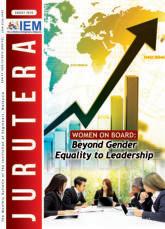


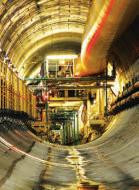


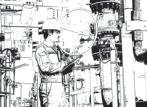
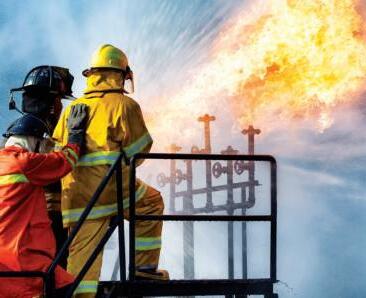






JURUTERA has an es�mated readership of 200,000 professionals. Our esteemed readership consists of cer�fied engineers, decision making corporate leaders, CEOs, government officials, project directors, entrepreneurs, project consultants, engineering consul�ng firms and companies involved with engineering products and services.


Our business partners can be assured that their products and services will be given the circula�on and exposure they deserve, thus maintaining a sustained adver�sing presence to our core readers of decision-making engineers and technical experts. Our website offers an even wider market reach, with added interna�onal presence, aided by our interna�onal affilia�on with official engineering bodies all over the world. Our online and offline adver�sing features such as banner adver�sing, ar�cle sponsorship and direct e-mail announcements have proven to be successful marke�ng strategies that will set the businesses of our partners apart from their compe��on.




We are moving towards a faster paced,borderless world where convergence,personalisation,being more informed, higher expectations as well as cost-effectiveness and knowledge are power. Various factors have influenced the development and adoption of technology in order to improve productivity and economic growth.
The severity of the COVID-19 pandemic and its impact on business worldwide are unprecedented. It has caused companies to shut down, supply chain disruptions, weak financial performance, retrenchment, etc. However, it has also become the catalyst for the digital transformation of Malaysian industries.
Malaysia has embraced the Industry 4.0 journey with various initiatives, such as National Policy on Industry 4.0 (Industry4WRD), National IoT Strategic Road Map, Malaysia Productivity Blueprint, Establishment of Digital Free Trade Zone(s) and Malaysia Digital Economy Blueprint 2021 (MyDigital). We are in a good position to recover from COVID-19 as we have these Digital Transformation initiatives and the process of integrating digital technologies into the national economy had started before the pandemic.
Still, strong commitment from the government and industries are necessary to lead the Malaysian economy by creating inclusive, high-quality growth through nationwide digitalisation initiatives that are aligned with our national policies. In addition, the industry also needs to have a positive as well as right mindset for the Digital Transformation journey.
Digital Transformation is transformation based on digitisation and digitalisation that further touches a company’s core business and is aimed at creating a new business model in line with current needs. It is the development of digital technology and supporting capabilities to create a new digital business model.There are three phases of Digital Transformation development (Figure 1):
1. Digitisation Conversion: Information digitisation, analogue data to 01 binary
2. Digital Upgrade: Process digitalisation, typically incorporating various IT application systems
3. Digital Transformation: Business digitalisation, typical of Amazon andApple
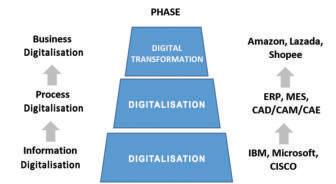
At the same time, another key description is given for Digital Transformation,which is that it enables a company to redefine its business systematically and comprehensively on information technology (IT),operation technology (OT) and communication technology (CT) as well as to redefine all aspects of organisational activities,processes,business models,and employee capabilities.
The Digital Transformation concept emphasises the application of digital technology and the reshaping of business processes or business models.Business reshaping is the fundamental goal and digital technology is just a tool to support the company strategy and business development.
Launched on 31 October 2018, the National Policy on Industry 4.0 (Industry4WRD) aims to transform the manufacturing sector and related services. Industry4WRD
covers the period from 2018 to 2025. The Ministry of International Trade & Industry (MITI) has been responsible for the development of the Industry4WRD policy since 2017, working with the Ministry of Finance, Ministry of Multimedia & Communications, Ministry of Human Resources, Ministry of Education and Ministry of Science Technology & Innovation as well as various agencies, industries and stakeholders. The policy has three visions and is aimed at making Malaysia:
• A strategic partner for smart manufacturing and related services in theAsia Pacific
• A primary destination for investment in the high value and high technology industry
• A total solutions provider for cutting-edge technology. The objectives were formulated on three main foundations:Attract (A),Create (C) andTransform (T).
• Attract (A): To attract stakeholders to shift towards Industry 4.0 applications and technologies, thereby enhancingMalaysia’sattractionasapreferredlocation for smart manufacturing
• Create (C):To create a holistic ecosystem to support the adoption of Industry 4.0 by industries and to coordinate existing initiatives in various related aspects such as talent and workforce, funding, infrastructure and regulation
• Transform (T): To enable a holistic transformation of the manufacturing sector to increase and strengthen productivity, cost efficiency, technology applications and innovation ability, development of local technology and development of more highly-skilled workers.
The primary enablers of the Industry4WRD policy can be accorded the acronym F.I.R.S.T.
• F:Funding and Outcome-based Incentives
• I:Enabling Ecosystem and Efficient Digital Infrastructure
• R:Regulatory Framework and IndustryAdoption
• S:Upskilling Existing and Producing FutureTalents
• T:Access to SmartTechnologies and Standards.
There are 13 strategies and 38 action plans. One of the main programmes is the Industry4WRD Readiness Assessment programme, which assesses the level of readinessofanorganisationinitsshifttowardsIndustry4.0. Its main objectives are:
• To create a guideline on the level of readiness in an organisation for the usage of Industry 4.0 elements
• To identify areas of improvement in every dimension measured
• To recommend further actions to enhance efficiency and productivity
• To develop a baseline for adoption by the industry.
The adoption of Industry 4.0 will assist the industry, especially small and medium-sized enterprises (SMEs), to increase efficiency and productivity in order to remain relevant and competitive at domestic and global levels.
The Industry4WRD policy will encourage the development
of Malaysian products and services using innovative manufacturing capabilities based on technology.
The digitalisation approach should be based on toplevel and holistic design, combined with the core competitiveness of enterprise, such as product design capabilities and future industrial interconnection as well as ecological development directions. Digitalisation is based on a company’s strengths and weaknesses, to determine its business strategy and goals.The essence of digital transformation has 3 main aspects.
Connectivity:All things are interconnected,solving the problem of connecting people with people, people with things and things with things.
Data:Interoperabilityisgeneratedaftertheconnectivity and the interoperability will generate data.
Intelligence:Dataisprocessedandrefinedforintelligent analysis and applications.
Connectivity solves fundamental interoperability issues through the business interoperability to capture data, cloud storage, data analytics and cloud computing to provide valuable feedback and business insight to the top management. At the same time, data continues to accumulate and further provides services for intelligent analysis applications such as machine learning and deep learning.
In the digital transformation framework of an enterprise (Figure 2), operation is supported by the core business valuechain,technologysupportandorganisationalsupport.
Operationalsupport::The core business value chain is continuously improved,based on data-driven thinking with the goal of creating and enhancing value.
Technologysupport: This includes Internet of Things (IoT),Big DataAnalytics (BDA),Cloud Computing,Building Information Modelling (BIM) and digital twins etc.,as well as the digital middle platform that integrates the digital support with the business needs.
Organisational support: Includes organisation, personnel,culture,process and other content.
Malaysia launched Industry4WRD at MITI Tower in 2018. Many local manufacturers are aware of Industry 4.0 and its potential for value enhancement. This is Malaysia’s response to the call for Digital Transformation of the manufacturing sector and its related services by facilitating companies to embrace the 4th Industrial Revolution (4IR) in a systematic and comprehensive manner as well as to be smarter and stronger through people, processes and technology. However, two years after its launching, many SMEs are still unable to translate their acquired knowledge to actionable transformation plans due to various factors.

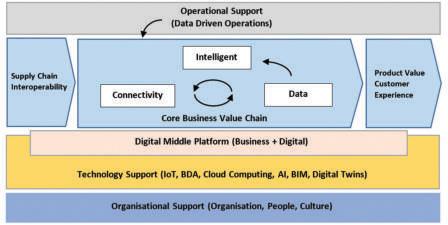
A Digitisation Self-Diagnostic Tool is an online survey tool that can be used as the first step to understanding the digitisation readiness of an enterprise.This tool has been cross-referenced with other survey tools from TUV SUD,IMPULS Foundation of the German Engineering Federation (VDMA), Warwick Manufacturing Group (WMG) the University of Warwick, Economic Development Board (EDB) Singapore and MITI.The Digitisation Self-Diagnostic tool is based on 3 cores,8 focus areas and 15 elements (Figure 3).

The Machinery & Equipment Productivity Nexus (MEPN), Malaysia Productivity Corporation (MPC), has developed the Productivity1010 programme to assist SMEs to answer their concerns about using the Digitisation Self-Diagnostic tool and this has established 4 key principles of prioritisation: Reality Check/Gap Analysis, Return on Investment, Review of Key Performance Indices and Reference to Best Practice. These principles, known as the 4Rs prioritisation framework, help SMEs to understand the digitisation areas where improvements made will deliver the greatest value enhancement.Thiswillallowenterprisestostart,scaleandsustaintheirDigital Transformation journey in the right direction.
The Productivity1010 programme is aimed at helping enterprises approach prioritisation in a systematic way that is robust and comprehensive.To assist local SMEs translate the principles into practice, a Prioritisation Matrix has been developed by MPC MEPN,with the support
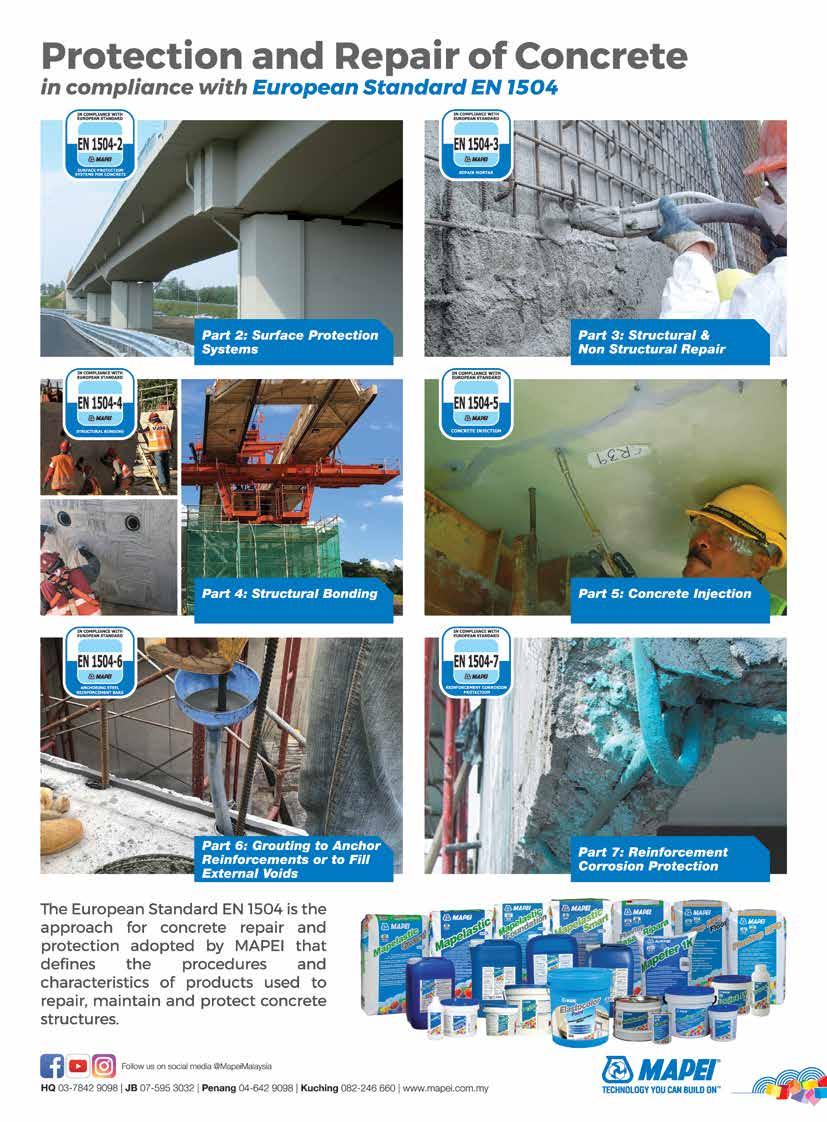
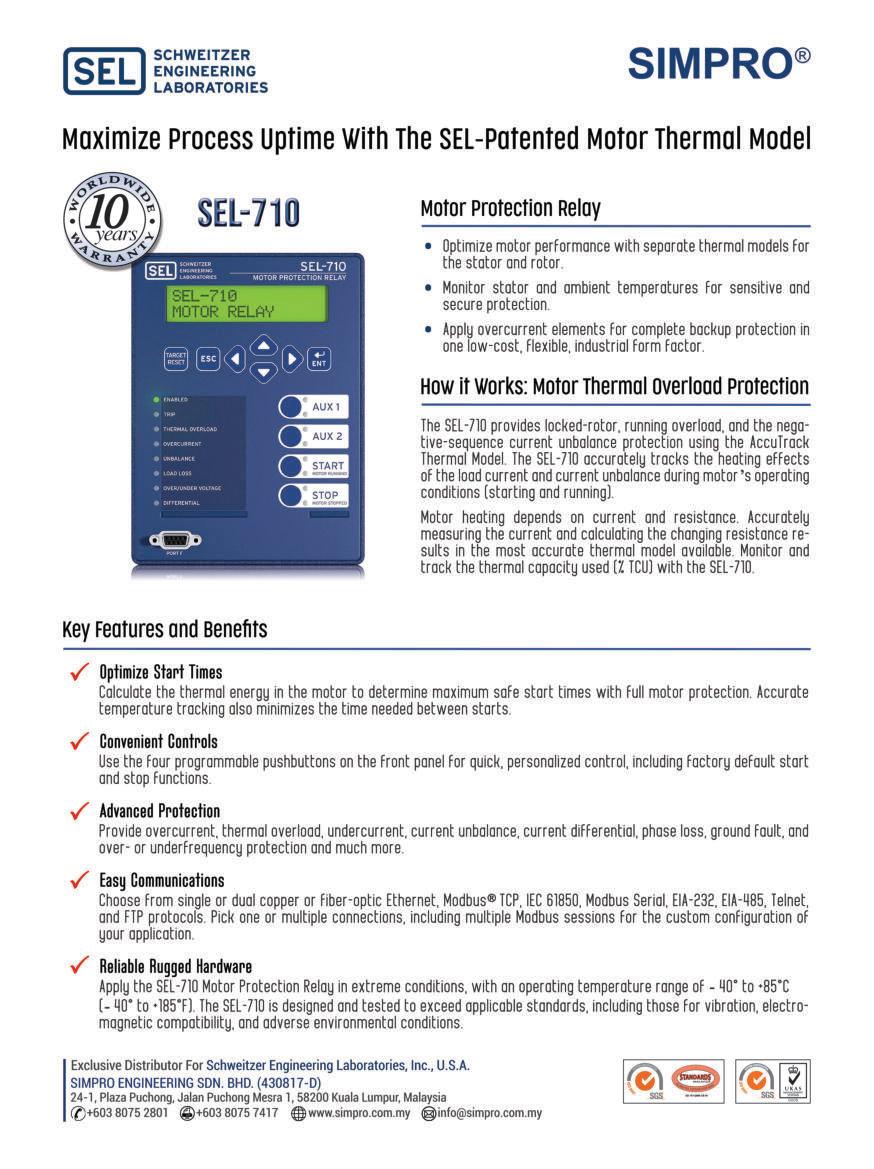
ENGINEERING SDN. BHD. 199701015320 (430817-D)
of the Machinery & Engineering Industries Federation (MEIF), Malaysia Automation Technology Association (MATA) and Malaysia Industry 4.0 Systems Integrator Association (MISI4.0).The goal is to assist enterprises in quantitatively identifying the high-priority areas based on the digitisation self-diagnostic input, profit & loss status, key performance indices, and proximity scores where improvements will bring the most benefit. Figure 4 shows an example of Prioritisation Matrix.
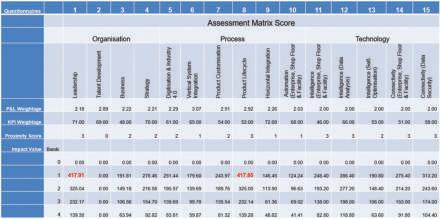
The next phase of the Productivity1010 programme focuses on projectbased assessment for Proof of Concept (PoC) initiatives. A technical expert will intervene in the Digital Transformation of a company and coordinate the PoC such as IoT.The technical expert will provide training under MyReskill programme about the PoC technology and guide the company in implementing PoC in its operations.The technical expert plays an important role to hand-hold the company in its digital transformation journey.The expected outcome will be the validation of the PoC in practice on-site, enhanced productivity growth for SMEs, enhanced digitalisation capabilities of SMEs and showcasing the success of the PoC.
Engagement with a Digital Transformation Consultant (DTC) will enable greater understanding of the context and give a better insight into a company’s operation as well as connect it with niche specialists and technology partners which are the best fit for its business needs. It is very important to engage a consultant with a combination of technical knowledge,change management skills and implementation experience.
The DTC plays an important role in assisting the company to create a clear strategy and roadmap of its DigitalTransformation journey.The DTC will be able to identify any gap in the Digital Transformation process as well as be an integral part of the process.A DTC will understand both the current traditional and the desired digital side of the business and will assist with change management in the company by designing a tailored strategy. A good DTC can formulate cost-effective solutions, solve complex business challenges and drive continuous improvement in the company.
The Consulting Engineers Special Interest Group (CESIG) is organising the 1stASEAN DigitalTransformation Symposium (ASEAN DIGITAL 2021) on 10 September2021inconjunctionwiththe1stMalaysiaEngineeringExhibition& Conference 2021 at Kuala Lumpur Convention Centre (KLCC).The objectives are:
• To create greater awareness among ASEAN engineering community on the latest digitisation and Industry 4.0 Enabling Technologies for the manufacturing sector




• To assist ASEAN Engineering community to learn to leverage on new technology and digitisation to improve business performance to grow and thrive
• To provide a platform for technology practitioners and manufacturerstonetworkandlearnfromeachotherand
• To promote the adoption of digitisation and Industry 4.0, enabling technologies to the ASEAN Engineering community for long-term benefits in the global market.
Digital Transformation is changing the way enterprises operate. Organisation, Process and Technology are all evaluated.It affects each level vertically and horizontally to connect and bring together data holistically for real-time, transparency and productivity. Digital Transformation is a journey to help enterprises grow and sustain growth for the long-term. It is important that enterprises have a proper strategy and road map for their digital transformation journey. In addition, the engagement of a DTC is very important to ensure the successful implementation of the right strategy and roadmap towards digital transformation. The enterprises need to be responsive, adaptive and resilient to face challenges and crises now and in the future.
“It is not the strongest of the species that survive, nor the most intelligent, but the one more responsive to change”
Quote by Charles Darwin
[1] Industry4WRD: National Policy on 4.0. Link: https://www.malaysia. gov.my/portal/content/30610.Accessed on 18April 2021.
[2] Industry4WRD: National Policy on 4.0. Link: https://www.miti.gov. my/miti/resources/National%20Policy%20on%20Industry%204.0/ Industry4WRD_Final.pdf.Accessed on 18April 2021.
[3] Productivity1010: Digitisation Self Diagnosis Tool. 2021. Malaysia Productivity Corporation.
[4] Productivity1010: Digitisation Prioritisation Matrix. 2021. Malaysia Productivity Corporation.
[5] Machinery & Equipment Virtual Advisory Clinics (MEVAC). 2020. Malaysia Productivity Corporation.
[6] Malaysia Digital Economy Blueprint (MyDIGITAL). https://www.epu.gov.my/sites/default/files/2021-02/malaysia-digitaleconomy-blueprint.pdf. Accessed on 18 April 2021.
[7] Prime Minister Office of Malaysia. Speech Text in Conjunction with MyDIGITAL and Malaysia Digital Economy Blueprint Launch Ceremony.
https://www.pmo.gov.my/2021/02/speech-text-in-conjunction-withmydigital-and-malaysia-digital-economy-blueprint-launch-ceremony/. Accessed on 18April 2021.
[8] The Edge Markets. Muhyiddin’s speech at MyDIGITAL, Malaysia Digtal Economy Blueprint launch ceremony.
https://www.theedgemarkets.com/article/muhyiddins-speechmydigital-malaysia-digital-economy-blueprint-launch-ceremony. Accessed on 18April 2021.
Authors’ Biodata
Ir. Dr Tan Chee Fai is Chairman, ASEAN Engineering Inspector for Manufacturing (AEI-MFG) andASEAN Engineering Register (AER) Digital Transformation Consultant,Malaysia Productivity Corporation
Dr Mazlina Shafii is Deputy Director,Malaysia Productivity Corporation
H.E. David Khor is Minister Counsellor (Investment), Embassy of Malaysia in Beijing (Investment Section) and Director, Malaysian Investment Development Authority, Beijing Office
Vincent Oh Kok Loon is Digital Transformation Consultant, Malaysia Productivity Corporation
Webinar - 2 Half-Day Course on Introduction to Internet of Things
Date: 17-18June2021 (Thursday-Friday)
Time: 9.00a.m. –1.00p.m.
Venue: DigitalPlatform
ApprovedCPD: 7.5
Speaker: Ir. DrHafizalMohamad
Webinar - One-Day Course on “Conducting HAZOP Study for Engineers, Scientists & Managers”
Date: 19June2021(Saturday)
Time: 9.00a.m. –5.30p.m.
Venue: DigitalPlatform
ApprovedCPD: 7
Speaker: Ir. DrJohnEow
Webinar on Selection, Protection & Maintenance of Transformers as per IEC 60076
Date: 23June2021(Wednesday)
Time: 2.00p.m. –5.00p.m.
Venue: DigitalPlatform
ApprovedCPD: Applying
Speaker: Variousspeakers
Webinar Talk on “Innovative Refining Technology to Reduce Harmful Contaminants in Food Using Refined Palm Oil”
Date: 25June2021(Friday)
Time: 3.00p.m. –5.00p.m.
Venue: DigitalPlatform
ApprovedCPD: Applying
Speakers: Mr. DanielNg Ir. HorKokLuen

by
When one thinks of Artificial Intelligence (AI), one sees a distant, futuristic setting similar to what we see in science fiction movies. However, the lines between current reality and fiction have blurred.AI is changingtheworldandthelivesofpeople;ithasbecome the engine of growth for businesses and economies aroundtheworld.WhenwedoaGoogleSearchorengage with a chatbot on a shopping website, we are already interacting with anAI-based tool.
AI and Digital Transformation are among new terms that engineers have faced in the last half decade. Currently graduating and future engineers are asking present practitioners about the impact these enabling technologies have on the engineering profession going forward. Is it still worth the while to pursue engineering as a career in view of the rapid pace of technological development? Clients of such engineering services are alreadyaskingengineershowthesetechnologiescanhelp improve and optimise their businesses.
This article explores the impact that AI and Digital Transformationwillhaveontheengineeringprofession.First a primer on some related definitions.
Artificial Intelligence (AI) is the science and engineering of making intelligent machines, especially intelligent computer programs.It is related to the similar task ofusingcomputerstounderstandhumanintelligence, but AI need not be confined to methods that are biologically observable.AI is intelligence demonstrated by machinesandthetermisoftenusedtodescribemachines that mimic cognitive functions that are associated with the human mind, such as learning and problem solving. AIhasseveralsubfields:MachineLearning(ML)andDeep Learning (DL).
MachineLearning is the study and application of computer algorithms that improve automatically through experienceandbythefrequentandrepeateduseofdata. It is a branch of AI and computer science.ML algorithms
build a model based on sample data,known as“training data”, in order to make predictions or decisions without being explicitly programmed to do so. ML algorithms are used in a wide variety of applications such as in medicine, email filtering and computer vision.
Deep Learning is a class of machine learning algorithms thatusesmultiplelayerstoprogressivelyextract higher-level features from the raw input. DL became popular in 2016 whenAlphaGo beat the then reigning Go world champion Lee Sedol*.
Perhaps a quote by a leading researcher,entrepreneur and practitioner of DL,Andrew Ng,is pertinent at this point. About a century ago, we started to electrify the world through the electrical revolution. By replacing steampowered machines with those using electricity, we transformed transportation, manufacturing, agriculture, healthcare and so on. Now,AI is poised to start an equally large transformation on many industries. For example, the IT industry (like Baidu) is totally transformed by AI.FinTech is also being totally transformed. Healthcare is starting to be, and there are huge opportunities there. Self-driving is an industry built onAI.Other industries,like search engines and food delivery, are also supported by AI. The only industry which will not be transformed will probably be hairdressing. AI is the new electricity.– Andrew Ng
*Inresponsetothematch,theSouthKoreangovernment announced on 17 March 2016 that it would invest $863 million (1 trillion won) inAI research over the next five years
Digital Transformation is the adoption of digital technologies to transform services or businesses through the replacing of non-digital or manual processes with digital processes or replacing older digital technology with newer digital technology. At the heart, Digital Transformation is a set of rapidly evolving and converging technologies that pushes the boundaries of technology adoption, technologies such as cloud computing, cybersecurity,IoT andAI.

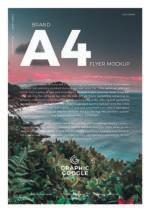






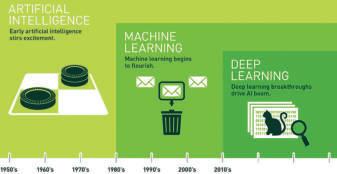
The term is also widely used in some sectors to refer to modest initiatives such as putting services online or legacy modernisation. McKinsey defines Digital Transformation as “an effort to enable existing business models by integrating advanced technologies”. Basically, it allows digital technologies to be integrated into already existing business models,changing the way organisations operate and deliver products or services.MIT’s George Westerman posits that Digital Transformation marks a radical rethinkingofhowanorganisationusestechnology,people and processes to fundamentally change business performance. The old term for Digital Transformation is Industry 4.0.
Digital Transformation is among several crucial initiatives that many businesses have pursued or are embarking on.The perfect storm of a wide range of technologies,i.e. the nine pillars of Digital Transformation such as Additive Manufacturing, Robotics, Industrial IoT,Augmented Reality (AR), Big Data, Cyber-Physical Security etc., is playing a crucial role in the Digital Transformation of companies.AI and the various sub-fields will be the key technologies to propel organisations in their DigitalTransformation.
Though AI started in 1956, its tools and techniques only made a tremendous leap forward recently with the advent of better processing power and hardware and the availability of a huge amount of data.
To put it in perspective,according to data compiled by VisualCapitalist,asingleinternetminutein2020holdsmore than 400,000 hours of video streamed on Netflix,more that 3.5 million video views on YouTube and nearly 42 million messages shared via WhatsApp.Compare this with only 4 years earlier in 2016:69,444 hours watched on Netflix,2.78 million video views onYouTube and 20.8 million messages shared onWhatsApp.
According to a recent study by the IDC,the suggestion is clear that Digital Transformation, with the help of AI, is the way to move forward. This stimulates the need to pursue a plan to define a new AI-based operating model, organisational structure, roles and communication
strategy to manage this transformation effectively.This is because the data that comes from IoT devices and Digital Transformation initiatives will have limited value without AI-based technologies that are able to find valuable information from the data generated.
To respond to the challenges of the Digital Transformation economy, companies will have to grow their AI/ML teams faster.AI involves teams with synchronous communications, process automation and advanced analytics, so professional profiles are required in each of these fields, which are combinations of knowledge of Telecommunications, Computer Science, Mathematics, Statistics and Engineering. Any company that is considering to implement AI technology, is advised to start preparing its processes for the correct and effective exploitation ofAI models as soon as possible.
Just like with many other industries,AI/ML/DL is changing perceptions and practices in engineering. Even though these technologies are now seemingly pervasive and ubiquitous, we shouldn’t overlook how truly remarkable they are and the incredible things they enable us to do today and will allow us to do tomorrow. For engineers,AI may cause the tasks they do to evolve rapidly and to help them do things they weren’t capable of doing before.
AI in the engineering sector uses both software and hardware components. As machines become more complex, they will be able to impact not only smart production lines and complex manufacturing tasks but will also be able to design and improve tasks over time — with little or no human intervention — through machine learning. Car manufacturers have been using robots in the production line for quite some time to improve output quality and productivity and these have gone from completing simple engineering tasks to handling many precision moves required for some of the most intricate parts of the process.
Tasks that engineers are responsible for can be enhanced with the support of AI tools. One example is Computer Aided Design (CAD) and Building Information Modelling (BIM) which is now a fundamental part of the daily design workflow. Tools like these will improve the capabilities of engineers to constantly seek new designs and optimisation options that were not possible before.
Another way AI can support engineering tasks is to break down silos between departments and to help effectively manage data to glean insights from it.AI can provide automation for low-value tasks, while freeing up engineers to perform higher-value tasks. By using ML techniques to discover patterns in the data,machines will be of incredibly important help in engineering judgment.
Next, we will discuss the impact of AI and Digital Transformation in two engineering disciplines, electrical and mechanical engineering.
One case of AI transforming electrical engineering is in electrical power system operation and management.The increase of processing power and the availability of big data has set a clear roadmap which transforms the way that a power system can be monitored and managed. We can now look at a power system with fine granularity andresolution(bothonthesupplyanddemandside)and perform sensible management and optimised use of the massive amount of data that ensues.
A possible development in the application of AI technologies is computerised, remotely managed smart home systems. Further development and improvement of smart home systems use Digital Transformation technologies,including cloud computing,IoT and ML etc. Currently,the key areas of smart home system improvement are the issue of safety/security and the management of various risk categories that occur in households and residential buildings,with safety being the topmost priority. AI can be exploited to improve the risk management processes.
Other areas where AI and Digital Transformation are impacting the electrical engineering profession is in the integration of various energy sources that allows the building and operation of a unified grid network and optimised dispatching of multiple resources such as gas, hydro, heat, hydrogen and electricity.The safe and secure integration of intermittent generation energy from
distributed generation sources depends on AI to allow these systems to be more secure,energy efficient,flexible, environmentally friendly and sustainable.

There are many ways in which mechanical engineering is adapting to a world that is increasingly becoming digital. AI and Digital Transformation are enhancing the product portfolio with digital functionalities and introducing creative,data-based services.
The transformation of mechanical engineering in DigitalTransformation promotes the development of smart industries which results in increased productivity,improved resource efficiency,reduced machine downtime,reduced

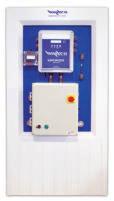
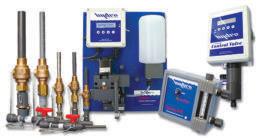
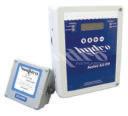
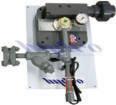

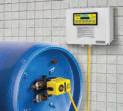

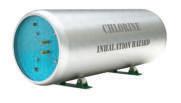

energy consumption, leading to reduced time to market. The AI contribution is in the power of intelligent predictive decision making, accelerating automating industrial processes.
Digital Twin is another area where AI and Digital Transformation are playing a transformative role. A Digital Twin is a real-time virtual replication of physical models using algorithms. It can be anything, from a product, a process or a service and has become cost-effective with IoT. It is like having your best product technicians with the most advanced monitoring, analytical and predictive capabilities at their fingertips and it can be used for everything, from electric vehicles and aircraft to new developments.
Another area where mechanical engineering takes advantage ofAI and DigitalTransformation is in 3D Printing. This rapid design and production method for making prototypes has grown so rapidly that the effect is being felt in many other industries outside the engineering fields, especially in medical and healthcare services.
The application of AI and Digital Transformation in sustainable or green manufacturing minimises waste and reducesthenegativeimpactontheenvironment.Itinvolves adopting practices that influence the process design, product design and operational principles.
While there are many benefits of AI in engineering, some engineers are concerned that their jobs will be taken over by machines.Automation has and will continue to take over jobs that humans have done traditionally; however, this will free humans to do higher-level and creative tasks as well as take over jobs that require the unique skills of human creativity and innovation that don’t even exist yet.
In a study by Stanford University titled One Hundred Year Study of Artificial Intelligence, there’s nothing imminent about the threat to jobs and,even when or if we get there, it will be balanced out by the positive impacts on society and the increased capabilities the technology offers.
Kai-Fu Lee,in his book,AI Superpowers,postulates that many jobs will be lost, jobs that require low dexterity and structured environment, so tellers, cashiers, dishwashers, entryleveltranslatorswillbeatahigherriskofreplacement in the next few years. Jobs such as physical therapists and home-care nurses are likely to be out of reach of automation in the foreseeable future. Jobs such as scientists and engineers that rely on manual dexterity in unstructured environments will have some tasks taken over by AI and automation,giving opportunities for these creativeprofessionalstouseAItoacceleratetheirprogress.
Engineers need to prepare to enhance their exploitation of AI and DigitalTransformation,when factory automation, big data, additive manufacturing, smart
technologies and cyber-physical security transform the way we work.Engineers should also be prepared to exploit the latest tools available to them and to learn how to work alongside robots and smart machines. Engineers must optimise the work that needs to be done so that the benefits of interactions between humans and machines are maximised.
AI and Digital Transformation are the foundation of advancedengineering.Whilethereremainquestions,most notably about how the roles of engineers will change, it is futile to resist the transformation.There’s no doubt that AI will help manage engineering data more efficiently and it will be an essential component of engineering in future.The sooner it’s adopted and adapted to,the sooner engineeringwillbeabletocapitaliseontheadvantagesof these technologies.
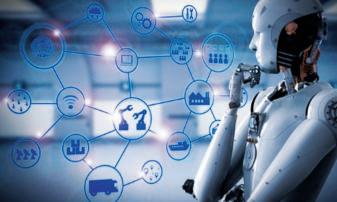
The COVID-19 pandemic has taught us that life continues evenwhenmostoftheworkforceislockeddown.Infact,itwas throughAI and DigitalTransformation that certain businesses were able to continue operations, albeit at a reduced level. Tesla continued to produce electric vehicles. NASA continued to proceed with the Mars Perseverance Lander mission which culminated in a successful landing on Mars this year. SpaceX successfully landed rockets on a drone ship. Manufacturers who had already embarked on the AI and DigitalTransformation journey suffered very little as their warehouses were remotely operated by robots.
AI and Digital Transformation are here to stay and are fuelling a transformation to make businesses more competitive and efficient. AI has already become a strategic factor in generating sustained growth and providing businesses with a competitive advantage. The challenge is in how we will manage the changes needed in the organisation structure,management culture and the investment needed to develop the right skills so that the workforce has the capability to adapt to this global trend thatisnowthenorminourprofessionalandpersonallives.
[1] https://homes.di.unimi.it/borghese/Teaching/ AdvancedIntelligentSystems/Old/IntelligentSystems_2008_2009/ Old/IntelligentSystems_2005_2006/Documents/Symbolic/04_ McCarthy_whatisai.pdf
[2] Mitchell, Tom (1997). Machine Learning. New York: McGraw Hill.
[3] Bengio, Yoshua; LeCun, Yann; Hinton, Geoffrey (2015). “Deep Learning”. Nature. 521 (7553): 436–444.
[4] https://www.gartner.com/en/information-technology/glossary/digitaltransformation
[5] George Westerman ; Leading Digital: Turning Technology Into Business Transformation
[6] https://www.miti.gov.my/miti/resources/National%20Policy%20 on%20Industry%204.0/Industry4WRD_Final.pdf
[7] Source for Figure 1 https://blogs.nvidia.com/blog/2016/07/29/whatsdifference-artificial-intelligence-machine-learning-deep-learning-ai/
[8] https://www.visualcapitalist.com/what-happens-internetminute-2016/
[9] Source for Figure 2 https://www.electricalindia.in/artificialintelligence-an-advanced-approach-in-power-systems/ [10] https://ai100.stanford.edu/2016-report
[11] Source for Figure 3 https://givingcompass.org/article/the-role-of-aiin-education-and-the-changing-u-s-workforce/ [12] Kai-Fu Lee (2018) ; AI Superpowers: China, Silicon Valley, and the New World Order
Ir.Tejinder Singh helms TJ Infinitium Sdn. Bhd., a boutique engineering advisory and consulting services company, operating in a space that intersects energy management, automation, artificial intelligence and industrial cyber security.
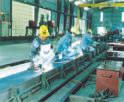
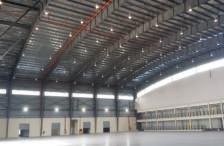


With deep regret, we wish to inform that Ir. Ismail Omar passed away on 21 May 2021. On behalf of the IEM Council and Management, we wish to convey our deepest condolences to the family.


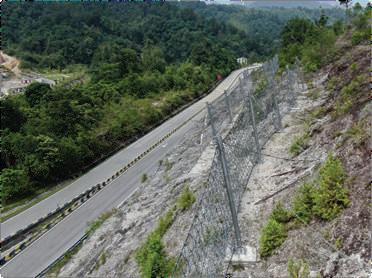
Throughout the years, Maccaferri has been constantly evolving and contribu�ng innova�ve solu�ons in Erosion Control, Retaining Walls, Basal Reinforcement, Soil Stabilisa�on, Rockfall Protec�ons, and various other applica�ons. We have extended our product range significantly over the last decade, enabling us to offer an unrivalled range of solu�ons to the environment. Maccaferri knowledge and experience enable us to offer clients tailored solu�ons, op�mising value, and achieving cost efficiency.
By Nurturing the world of tomorrow, harmonizing life and nature through innova�ve solu�ons, Maccaferri pursues excellence and con�nuous improvement.
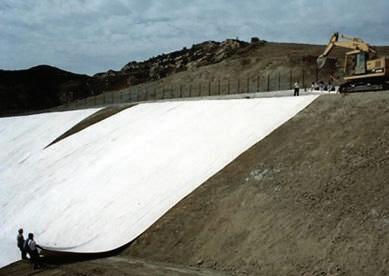

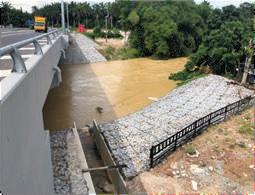
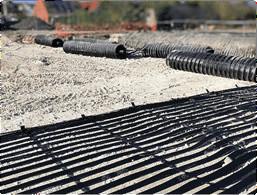






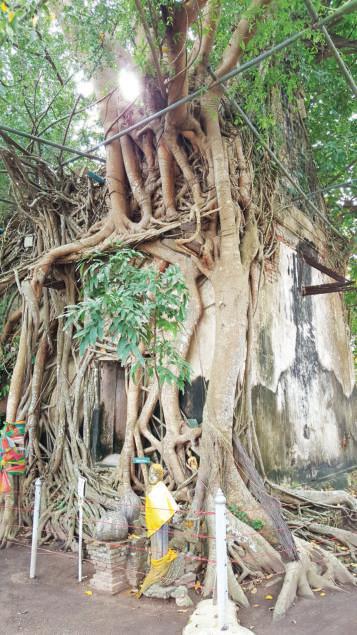

Ir. Dr Oh Seong Por
Ir. Dr Oh Seong Por is the immediate past chairman of IEM Negeri Sembilan Branch.
Wat Bang Kung (Bang Kung Temple) is an ancient Buddhist temple in Thailand built during the Ayutthaya Period. It is located in Samut Songkhram Province where Siamese King Taksin The Great of the Thonburi Kingdom defeated the invading Burmese army in 1768.After the victory, King Taksin abandoned the place and the temple was left to co-exist with the surrounding trees.
Overtheyears,therootsoflong-livingtrees likePho(bodhior Ficus religiosa),Sai(banyan or Ficus benghalensis), Krai (Dracaena kaweesakii) and Krang grew and covered the entire temple. The roots provide natural protection and have kept the temple intact to this day.
These are truly Mother Nature-engineered walls. The overgrown roots also created the impression that the temple was built inside the trees. This is why Wat Bang Kung is also popularly known asTheTemple ofTrees.There is a statue of the Buddha located in the hall. Devotees would walk around the statue and paste gold papers on it to produce a shining appearance under sunlight.
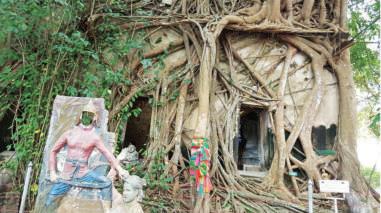
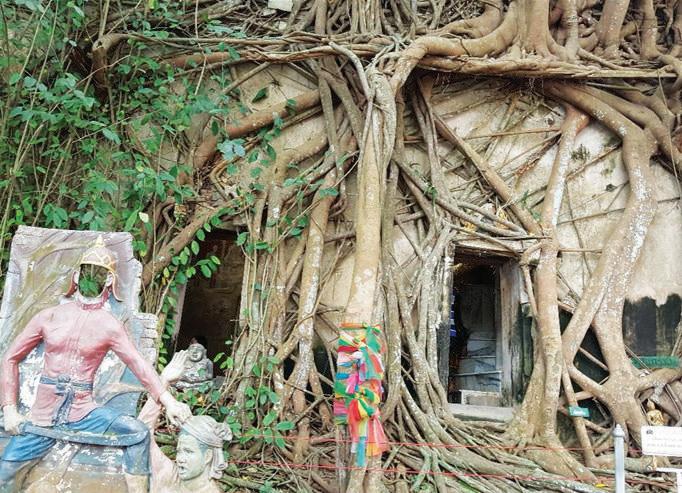

by Mr. Muhd Ashiq Marecan bin Hamid Marecan
The Consulting Engineering Special Interest Group (CESIG), The Institute of Engineers, Malaysia (IEM) organised a virtual workshop on Introduction To ElectricalDesignInBuildingServiceson23and30January 2021,held over 2 half-day sessions.There were more than 300 participants.
This was the first virtual workshop organised by CESIG on GoToWebinar platform and was supported by The Electrical & Electronics Association of Malaysia (TEEAM). ItwasconductedbyIr.MohdTaufikbinMohammedRathi, a Professional Engineer with Practicing Certificate (PEPC) in the Mechanical & Electrical (M&E) consulting field.He hasvastexperienceandknowledgeinthedesignofM&E servicesforhighrisebuildings,hospitals,mixedcommercial developments,apartmentblocksandothersuchfacilities.
The aim was to provide in-depth coverage of topics directly related to electrical design theory,the Regulatory provisions that such designs have to comply with, practical implementation guidelines in the design and construction of such projects and good engineering practice in accordance with Malaysian Standards
to benefit participating electrical and mechanical engineers, contractors, consultants, project managers, facility managers and others who wish to enhance their professional experience and competence.
The workshop topics were:
• Introduction to the scope of Electrical Building Services
• Regulations,Standards and Codes in force in Malaysia
• Electricity supplyVoltages: • Low Voltage (LV) Distribution System, • Medium Voltage (MV) Distribution System
• Standby Generator System requirements
• Lightning Protection and Earthing Systems
• Telecommunication Services and
• ELV Services.
Participants were provided with a learning module and certificateofattendanceindigitalformat.Thisisinlinewith thenewpracticeofgoingpaperlessduringthepandemic period so as to reduce pollution of the environment.
Webinar Course on "Lifecycle Cost of Energy Efficiency-Green Project"
Date: 26 June 2021 (Saturday)
Time: 9.00 a.m.– 5.00 p.m.
Venue: Digital Platform
Approved CPD : 7
Speaker: Ir.Noor Iziddin Abdullah bin Hj Ghazali
Webinar Talk on "Ship Resistance Powering"
Date: 28 June 2021 (Monday)
Time: 3.00 p.m.– 5.00 p.m.
Venue: Digital Platform
Approved CPD :Applying
Speaker: Prof.Dr Adi Maimun

by Ir. Dr Tan Chee Fai
The COVID-19 pandemic has impacted Malaysia since March 2020. Besides implications to public health, it has significantly impacted businesses and the economy. Bringing fast-moving and unexpected variables to the engineering industry as well, it has become the catalyst of digital transformation for small and medium enterprises (SMEs).
Since May 2019, the Consulting Engineering Special Interest Group (CESIG) had organised a total of 14 Industry4WRD webinars which contributed 24.5 CPD hours (Table 1). The aim was to assist IEM members to understand the digital transformation principles and mechanisms as well as to support the Malaysian National Policy on Industry 4.0 (Industry4WRD).
Ir. Dr Tan Chee Fai, Digital Transformation advisor of Malaysia Productivity Corporation, Chairman of ASEAN Engineering Inspector for Manufacturing (AEI-MFG) and Technical Expert of ISO/IEC Smart Manufacturing Map Task Force,was the speaker in the series of Industry4WRD webinars.
Ir. Dr Tan shared his experiences and expertise on Malaysia National Policy issues in Industry 4.0 and Digital Transformation. He started the series in May 2020, focusing on industry insights, especially the impact of COVID-19 on industry operations. During the first movementcontrolorder(MCO1.0)from18March2020to 3 May 2020,many SMEs were not able to operate except for those involved in the movement of essential goods such as food.
The economic impact of MCO 2.0 was less onerous for SMEs. However, operations were allowed only for companies categorised under “essential industry”, with the operational capacity limited to a minimum level or reduced by at least 50%. Many employees had to Work FromHome(WFH)asoneofthewaystocontrolthespread of the COVID-19 infections.
Our products:




Thus,COVID-19 had impacted the industrial activity and stimulated the industry to rethink their current business practices. One of the immediate strategies for these businesses was to opt for digital adoption in order to speed up their recovery from COVID-19 implications as well as to build up resiliency and sustainability in their business.
In response to the Fourth Industrial Revolution, Malaysia launched Industry4WRD: National Policy on Industry 4.0 on 31 October 2018 to drive the digital transformation of the manufacturing and related services sectors in the country. MITI introduced various initiatives such as Industry4WRD readiness assessment, Industry4WRD intervention programme and Industry4WRD Domestic Investment Strategic Funds (DISF) programme. The set of shift factors of Industry4WRD are People, Processes and Technology. The goal was to transform SMEs to achieve labour productivity growth, higher manufacturing contribution to the economy and an increment in innovation capacity and highly skilled jobs. In addition, the National Economic Recovery Plan or Pelan Jana SemulaEkonomi Negara (PENJANA) launched Smart Automation Grant (SAG) in December 2020.The PENJANA SAG would assist and incentivise SMEs and Mid-Tier Companies (MTCs) to automate and digitalise operations,production and trade channels.
With the new normal arising from the COVID-19 pandemic, there is a significant acceleration of Malaysian SMEs towards digital transformation. The industry sector has already started to look for total solutions that are able to reduce their pain points,such as low efficiency in production, reliance on low skilled foreign workers, low production volumes,long working hours and high defects rate.DigitalTransformation is one important option for SMEs to increase their competitiveness and to promote sustainable growth. Digital Transformation is a journey, not a destination.The right strategy and road map are important for SMEs in their unique digital transformation journey.
Webinar Talk on “Advantages of BIM in Building Projects”
Date: 30 June 2021 (Wednesday) Time: 3.00 p.m.– 5.00 p.m.
Venue: Digital Platform Approved CPD :Applying
Speaker: Ir.Mohd Faiz bin Shapiai
Webinar - Technical Talk on “Turbocharger Optimisation via Evolutionary Algorithm”
Date: 1 July 2021 (Thursday) Time: 10.00 a.m.– 12.00 p.m.
No. 45-3, Jalan PJU 5/20
The Strand, Kota Damansara 47810 Petaling Jaya Selangor Darul Ehsan : 012 355 9151 : 012 329 3378 (Whatsapp only)
Tel : 603 6142 6638
Fax : 603 6142 6693
Email : leehuiseng@nehemiahwalls.com
Email : enquiry@nehemiahwalls.com
Venue: Digital Platform
Approved CPD : 2
Speaker: Dr Uswah Khairuddin
One-Day Physical Course on Microsoft Project
Date: 3 July 2021 (Saturday)
Time: 9.00 a.m.– 5.00 p.m.
Venue: Digital Platform Approved CPD :Applying
Speaker: Ir.Faizal A.Sanusi


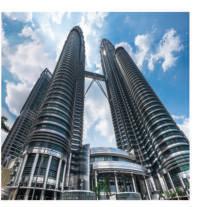
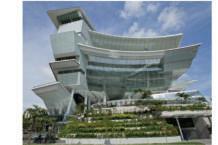

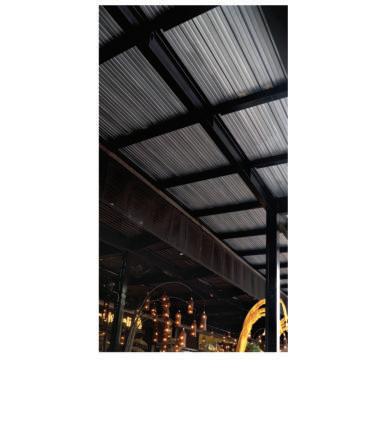



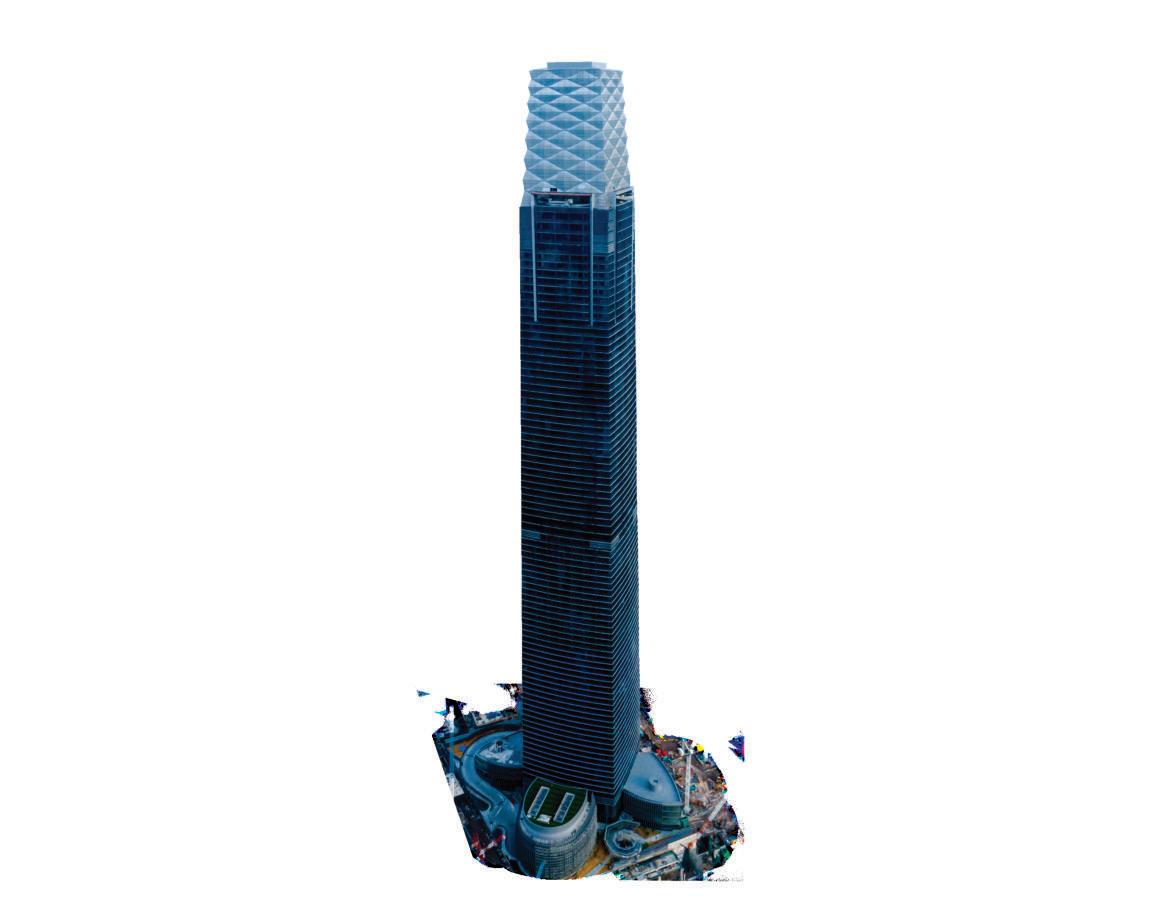


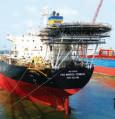
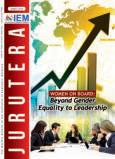

















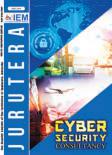

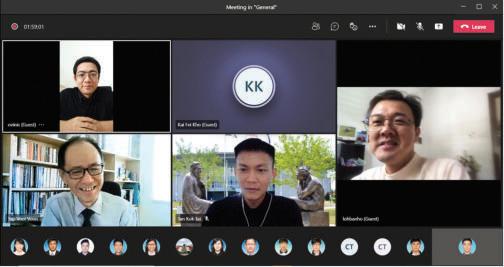
The Institution of Engineers Malaysia (IEM) Perak branch supported and sponsored the virtual Final Year Project (FYP) poster competition organised by UTAR Faculty of Engineering & Green Technology (FEGT), Kampar Campus.
The annual event, held on 21 April 2021, was aimed at providing engineering students with a platform to showcase the results of their FYP to the industry panel as well as to encourage and strengthen the link between local SMEs and the university to promote work-based learning for the benefit of the students.
A total of 90 posters were submitted.The top winners from each department then presented their works to a panel of judges comprising Ir.Loh Ban Ho (Chairman,IEM Perak Branch),Ir.Dr Mark Olvinis and Mr.Koh Kai Fei (IEM PerakYoung Engineers Section).
With this, the final-year students could communicate and present their works as well as strengthen their engineering knowledge during the question-and-answer sessions. This was important to enable the university to
produce market-ready graduates to meet the industry’s needs. The competition further developed the students’ critical thinking on how they could ensure that their FYP outcome could benefit the industry and society.
Electronic Engineering student Kau Ming Jiun emerged champion with his FYP titled “Eczema Lesions Segmentation using Deep Neural Network (U-Net, U-Net++ & ResUNet++)”. His study focused on solving the problem in segmenting skin lesions of eczema without the help of a specialist,by developing a deep learning model for segmentation.
ChinYunTong,an Environmental Engineering student, won 1st Runner-Up with her research topic, “Thermal Activated Persulphate Oxidation on Landfill Leachate”, which focused on using the activated persulphate oxidation method to treat landfill leachate.
The 2nd Runner-Up was Wong Kai Meng from the Construction Management Department for his poster titled “Effective Risk Management Plan of Residential Building Project during the Construction Stage in Ipoh”. His study focused on identifying the significant risks of residential building projects in Ipoh during the construction stage and then investigating and evaluating the current risk management practices during this stage.
The virtual poster competition fostered a strong collaborationbetweentheindustryandtheuniversityand students were exposed to critical and industry-related problems.

by Amanda Siaw


IEM Monash Student Section organised a workshop on resume writing and job interviews on 5 April 2021, from 3pm to 5pm.It was held during the mid-semester break so as to allow more students to take part in and to benefitfromtheworkshop.Therewasatotalof75students, including the committee members.
The main objective was to help students acquire a betterunderstandingofhowtowriteanimpactfulresume and how to effectively prepare for a job interview.
The two speakers had vast experience in recruiting employees for the award-winning engineering company, Gamuda Berhad.The first speaker,Mr Keith Gabriel Gan, explained the differences between a CV and a resume. He then shared techniques on how to prepare an effective resume that would contain the right information.
The second speaker, Encik Muhammad Afiq Coppey, talked about how to prepare for a job interview and what to expect. He said an interviewee should be mentally prepared, be honest and to anticipate potential basic and hard questions.He also shared the dos and don’ts of an interview.
The presentation ended in a Q&A session. The workshop was also a great opportunity to promote IEM Monash Student Section to the participants, many of whom had yet to sign up as members.It was an insightful afternoon for everyone. IEMMSS hopes to organise more similar events in the future.
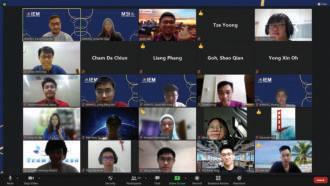

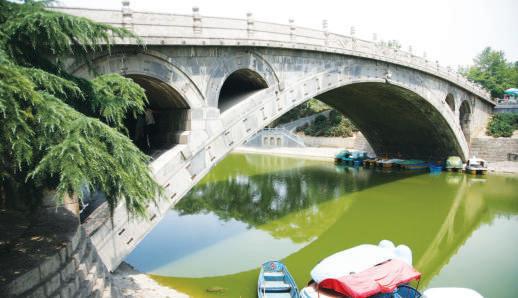
45kms to the west of Shijiazhuang, the capital city of China’s Hebei province, is a park that has been uniquely named after a bridge in it.It took my wife,my son and I about an hour to get there by bus from Shijiazhuang, during a trip that we made at the end of June 12 years ago.
We were then travelling by train over a period of 3½ months from Malaga, our starting point in southern Spain, to Ho Chi Minh City in Vietnam, passing through much of Europe, Russia and China, on what was believed to be the longest train journey in the world.
What attracted us to visit this park during that trip was not the park itself but the bridge. Zhaozhou Bridge was named after the county where it was located. Also known as Anji Bridge,it has a long history.It was constructed between AD595 and 605 during the Sui Dynasty, almost
1,420 years ago. It is a single-span masonry bridge with an arch that spans a distance of 37.37m.The total length of the bridge is about 50m.
When almost all contemporary bridge builders believed that only arches in the form of a semi-circle would be strong and stable enough to withstand their own weight and carry the superimposed loads, the shallow arch of the Zhaozhou Bridge was hailed as an engineering milestone at that time.
The man who received accolades for this extraordinary achievement was an exceptionally skilled mason named Li Chun. His ingenuity in the design and construction of this bridge could be seen in two areas: Firstly, he achieved the wide span of the bridge by using 28 parallel and abutting arches, each formed with massive, precisely-cut and wedged limestone voussoirs where joints were strengthened with wrought-

Ir. Chin Mee Poon is a retired civil engineer who derives a great deal of joy and satisfaction from travelling to different parts of the globe, capturing fascinating insights of the places and people he encounters and sharing his experiences with others through his photographs and writing.
iron cramps or bars. Secondly, the spandrels over both sides of the main arches were constructed with two small arched openings to reduce weight as well as the lateral forces on the bridge due to flood waters.
These novel design features and construction techniques have not only given the bridge tremendous strengthbuthavealsoprovideditwith the flexibility required to withstand earthquakes.
The bridge had undergone a number of repairs over the years; the 8th and last repair job was completed in 1958.However,the main structural elements of the bridge have survived the ravages of several wars, floods and earthquakes and have remained practically intact.The bridge continues to serve its original function of bridging the Xiao River.
Zhaozhou Bridge may not be imposing or awe-inspiring in size or appearance,but its significance lies in the fact that it marks a milestone in the long history and evolution of bridge engineering.Today, Zhaozhou Bridge is China’s oldest standing bridge as well as the world’s oldest open-spandrel segmental arched masonry bridge. In 1991, the American Society of Civil Engineers dedicated the bridge as an International Historic Civil Engineering Landmark.
I am truly pleased to have had the opportunity to visit yet another engineering masterpiece during my travels. The advancements made in the design and construction of this bridge have indeed enhanced my sense of pride in being a member of the great profession of civil engineering.
Kepada Semua Ahli,
Tarikh: 19 Mei 2021
Berikut adalah senarai calon yang layak untuk menduduki Temuduga Profesional bagi tahun 2021.
Mengikut Undang-Undang Kecil IEM, Seksyen 3.8, nama-nama seperti tersenarai berikut diterbitkan sebagai calon-calon yang layak untuk menjadi Ahli Institusi, dengan syarat bahawa mereka lulus Temuduga Profesional tahun 2021.
Sekiranya terdapat Ahli Korporat yang mempunyai bantahan terhadap mana-mana calon yang didapati tidak sesuai untuk menduduki Temuduga Profesional, surat bantahan boleh dikemukakan kepada Setiausaha Kehormat, IEM. Surat bantahan hendaklah dikemukakan sebulan dari tarikh penerbitan dikeluarkan.
Ir. Dr David Chuah Joon Huang Setiausaha Kehormat, IEM (Sessi 2020/2021)
PERMOHONAN BARU / PERPINDAHAN MENJADI AHLI KORPORAT
Nama Kelayakan
KEJURUTERAAN ELEKTRONIK
MOHD HISYAM BIN MOHD RAMLI BE HONS (UiTM) (ELECTRICAL, 2005)
KEJURUTERAAN MEKANIKAL
MUHAMMAD HATTA BIN MHD YUSOF BE HONS (UTP) (MECHANICAL, 2007)
PERPINDAHAN AHLI
No. Ahli Nama Kelayakan
KEJURUTERAAN AWAM
96028 MOHD ZAMALI BIN ZAKARIA BE HONS (UiTM) (CIVIL, 2007)
92347 MUHAMMAD FATHI BIN ABDUL AZIZ BE HONS (USM) (CIVIL, 2014)
49976 NG GUO SHEN BE HONS (LEEDS) (CIVIL AND STRUCTURAL, 2010)
111570 TAI YOONG HOU BE HONS (UTAR) (CIVIL, 2013)
108441 YEE WAI FUNG BE HONS (UKM) (CIVIL & STRUCTURE, 2004)
KEJURUTERAAN ELEKTRIKAL
66360 CHUA KEIN HUAT BE HONS (UKM) (ELECTRICAL, ELECTRONIC AND SYSTEMS, 2004) ME (MALAYA) (2009) PhD (UTAR) (2017)
114796 ABU HASSAN BIN MOHAMMED NAZARI BE HONS (QUEENSLAND) (ELECTRICAL, 2016)
86001 FAISAL IRSHAD BIN HARUN BE HONS (UNITEN) (ELECTRICAL, 2012)
53432 HEW KEAN SING BE HONS (UTAR) (ELECTRICAL & ELECTRONICS, 2014)
71831 MOHAMAD NAZRI BIN MOHAMAD DIN BE HONS (UTeM) (ELECTRICAL (CONTROL, INSTRUMENTATION & AUTOMATION, 2014)
114709 MOHD ASRI BIN ARSHAD BE HONS (MIDDLESEX) (ELECTRONIC, 1997)
34003 NOOR AZMI BIN MOHD RADZI BE HONS (UiTM) (ELECTRICAL, 2006)
59906 SYAHRUL NIZAM BIN MD SAAD BE HONS (UNITEN) (ELECTRICAL & ELECTRONICS, 2005) ME (UNITEN) (ELECTRICAL, 2012) PhD (EDINBURGH) (2020)
KEJURUTERAAN MEKANIKAL
90170 BEH HAO XIANG BSc (KENTUCKY) (MECHANICAL, 2010)
KEJURUTERAAN PEMBUATAN
78895 MOHD ROHAIZAD BIN MOHD RAZALI BE HONS (UTeM) (MANUFACTURING(MANUFACTURING MANAGEMENT), 2009)
Webinar - One-Day Course on “Offshore Sand
Separation: Design, Operation and Maintenance”
Date : 3 July 2021 (Saturday)
Time : 9.00 a.m. – 5.30 p.m.
Venue : Digital Platform
Approved CPD : 7
Speaker : Ir. Dr John Eow
SENARAI PENDERMA KEPADA WISMA DANA BANGUNAN IEM
Institusi mengucapkan terima kasih kepada semua yang telah memberikan sumbangan kepada tabung Bangunan Wisma IEM. Ahli-ahli IEM dan pembaca yang ingin memberikan sumbangan boleh berbuat demikian dengan memuat turun borang di laman web IEM http://www.iem.org.my atau menghubungi secretariat di +603-7968 4001 / 5518 untuk maklumat lanjut. Senarai penyumbang untuk bulan April 2021 adalah seperti jadual di bawah:
NO. NO. AHLI NAMA
07691 MR. IDRIS BIN MOHAMED @ MAMAT
07039 Ir.
CONTINUATION FROM MAY ISSUE 2021
PERMINDAHAN KEPADA AHLI SISWAZAH
No. Ahli Nama Kelayakan
KEJURUTERAAN MEKANIKAL
86954 KEE JIA MING, RYAN BE HONS (UTAR SG LONG)(MECHANICAL, 2020)
86993 KUMARESWARAN A/L SUNTHRA SAKARAN BE HONS (UTAR)(MECHANICAL, 2017)
72848 LEE YONG SENG BE HONS (UTeM)(MANUFACTURING PROCESS, 2015)
89323 LIANG BAO WEN BE HONS (UTAR SG LONG)(MECHANICAL, 2020)
99032 LINGESWARAN A/L SUNDARAMOORTHY BE HONS (UTAR SG LONG)(MECHANICAL, 2020)
99018 LUM KHAI YET BE HONS (UTAR SG LONG)(MECHANICAL, 2020)
31354 MATZAINI BIN KATON BE HONS (UiTM)(MECHANICAL, 2009) MSc (UiTM)(MECHANICAL, 2014)
40380 MOHAMAD AZZAD BIN MOKHRI BE HONS (UTM)(MECHANICAL, 2011)
50491 MOHAMAD HIZAMI BIN MOHD NOOR SHAHARUDIN BE HONS (UiTM)(MECHANICAL, 2016)
78836 MOHAMAD MIZAL SAIFUL ANUAR BIN MAZLAN BE HONS (UTP)(MECHANICAL, 2017)
80607 MOHD AMIRUL HADI BIN ROSLI BE HONS (UKM)(MECHANICAL, 2018)
39681 MOHD FIRDAUS BIN MOHD YUSOF BE HONS (UTHM)(MECHANICAL, 2011)
43459 MOHD FITRINIZAM EZANEE BIN BUNGSU BE HONS(UMS)(MECHANICAL, 2013)
45117 MOHD ZULFADZLI BIN MOHD RIDZUAN BE HONS (THE UNI. OF NOTTINGHAM)(MECHANICAL, 2012) ME (UNI. OF MALAYA)(MECHANICAL, 2019)
23397 MOY WAI HOONG BE HONS (UTM)(MECHANICAL, 2005) ME (MMU)(MICROELECTRONICS, 2014)
76685 MUHAMMAD ADRIAN THOMAS BE HONS (UTHM)(MECHANICAL, 2018)
74502 MUHAMMAD AIMAN BIN MOHAMMAD ARIFF BE HONS (UTM)(MECHANICAL, 2017)
75720 MUHAMMAD HAZIM BIN AZMAN BE HONS (UiTM)(MECHANICAL, 2018)
67682 MUHD FAKHIRUDDIN B. MOHD AFFANDI BE HONS (UiTM)(MECHANICAL, 2017)
96154 NG G-LIANG, JULIEN BE HONS (UTAR SG LONG)(MECHANICAL, 2020)
96166 ONG JUEN HAU BE HONS (UTAR SG LONG)(MECHANICAL, 2020)
97937 QUAH KENG TENG BE HONS (UTAR SG LONG)(MECHANICAL, 2020)
96174 TAN ROE DJER BE HONS (UTAR SG LONG)(MECHANICAL, 2020)
58807 YOGESWARAN A/L MARATHAIVERAN BE HONS (UTHM)(MECHANICAL, 2016)
89245 YONG MUN CHUN, VINCENT BE HONS (UTAR SG LONG)(MECHANICAL, 2020)
KEJURUTERAAN MEKATRONIK
97388 TAN JING YI BE HONS (UTAR SG LONG)(MECHATRONICS, 2020)
96180 TEOH HAN WEI BE HONS (UTAR SG LONG)(MECHATRONICS, 2020)
KEJURUTERAAN PETROLEUM
60720 DHARSHINI YEAP MAY CHEN BE HONS (UTP)(PETROLEUM, 2016)
PERMOHONAN MENJADI AHLI SISWAZAH
No. Ahli Nama Kelayakan
KEJURUTERAAN AERONAUTIKAL
111791 CHIN KEAN SHIUNG DCAM PART 66 AIRCRAFT MAINTENANCE ENGINEERS LICENSE TYPE C (CAAM)(AERONAUTICAL, 2018)
112321 MURUGAN A/L VARAHARAJID DCAM PART 66 AIRCRAFT MAINTENANCE ENGINEERS LICENSE TYPE C (CAAM) (AERONAUTICAL, 2018)
112205NUR IZZAIDAH BINTI GHAZALI ME (MOSCOW AVIATION INST.)(AIRCRAFT & HELICOPTER DESIGN, 2012)
KEJURUTERAAN ALAM SEKITAR
114744LOH XIANG RUBE HONS (UTAR KAMPAR) (ENVIRONMENTAL, 2020)
114741SIAH WEELIAMBE HONS (UTAR KAMPAR) (ENVIRONMENTAL, 2020)
KEJURUTERAAN AWAM
112196 ADIBAH BINTI AMIR SHARIFUDDIN BE HONS (UPM)(CIVIL, 2016)
111598AHMAD RASHDAN BIN MANSOR BE HONS (UMP)(CIVIL, 2014)
111859AHMAD SYIHAN SYAKIRIN BIN ZULKIFLI BE HONS (USM)(CIVIL, 2016)
111568AHMAD ZARRUQ BIN MOHD HANAFI ME HONS (THE UNI. OF SHEFFIELD)(CIVIL, 2019)
112467 ALYAAALIANA BINTI OTHMAN BE HONS (UiTM)(CIVIL, 2017)
112217BAHARUDIN BIN MOHDBE HONS (UTM)(CIVIL, 1999) 114763CHAN JIN CHUANBE HONS (UTAR SG LONG) (CIVIL, 2020)
112475CHAN MEN HOOBE HONS (UMP)(CIVIL with ENVIRONMENTAL, 2013)
111823 CHEW YUN LIEH BSc (UNI. OF WOLVERHAMPTON) (CIVIL, 2006) ME (UTM)(CIVIL, 2013)
114762CHIAN WEI XUANBE HONS (UTAR SG LONG) (CIVIL, 2020)
111862CHONG EE SINGBE HONS (UTM)(CIVIL, 2009)
114760CHU WEI JIETBE HONS (UTAR SG LONG) (CIVIL, 2020)
111824CHUNG KAH SENG, RICHMOND BE HONS (UTAR)(CIVIL, 2020)
111563CHUO NENG KEE, CLEMENT BE HONS (CURTIN UNI. OF TECHNOLOGY)(CIVIL & CONSTRUCTION, 2016)
111826Dr KUEH SZE MIANGBE HONS (SWINBURNE UNI. OF TECH.)(CIVIL, 2011) PhD (SWINBURNE UNI. OF TECH.)(2016)
111574ESMAN SHAM BIN SHAMSUL BOHARE BE HONS (UTM)(CIVIL, 2016)
111565GOH JIA CHERNGME HONS (THE UNIVERSITY OF SHEFFIELD)(CIVIL & STRUCTURAL, 2019)
112214HERDA BALQIS BINTI ISMAIL BE HONS (UTM)(CIVILENVIRONMENTAL, 2004
111843IZDIHAR NISZAR SYAFIQ BE HONS (UTM)(CIVIL, 2016)
111866KAMIL BIN IDRISBE HONS (UiTM)(CIVIL, 2014)
112186KELLY ERNOLD JOSEPH BE HONS (UTHM)(CIVIL, 2012)
112349KONG KAI HUANGBE HONS (SWINBURNE UNI. OF TECH.)(CIVIL, 2019)
114758KOO JIA CHENGBE HONS (UTAR SG LONG) (CIVIL, 2020)
111863LAI WEI LIBE HONS (UPM)(CIVIL, 2014)
111564LAU ZHI SENG, JOHN BE HONS (RMIT)(CIVIL & INFRASTRUCTURE, 2015) ME (RMIT)( STRUCTURES & FORENSICS, 2016)
112352LAU ZHI XIANBE HONS (RMIT)(CIVIL, 2018)
112216 LAW TECK ONN ME (UNI. OF MELBOURNE) (CIVIL, 2019)
112343LEE KAH WOONBE HONS (INTI INT. UNI.) (CIVIL, 2013)
114757LIEW XIAN HUABE HONS (UTAR SG LONG) (CIVIL, 2020)
112458LIM JIAN XIANGBE HONS (UTAR)(CIVIL, 2014)
112336 LIM YANG SOH BE HONS (USM)(CIVIL, 2016)
111596 LING KIONG, THOMAS BE HONS (CURTIN UNI. OF TECHNOLOGY)(CIVIL & CONSTRUCTION, 2016)
111852LOW BOON KIATME (THE UNI. OF MELBOURNE)(CIVIL with BUSINESS, 2018) BE (THE UNI. OF MELBOURNE) (ENVIRONMENTS, 2017)
112324LYN KAUTHAR SABRINA BINTI ALI SABRI SANI BE HONS (UTP)(CIVIL, 2019)
112470MEGAT MOHD WISWAN B MGT MAZELAN BE HONS (UTM)(CIVIL, 2002)
112323MOHAMED SYAFIQ BIN ROSLI BE HONS (UiTM)(CIVIL, 2016)
112449MOHD DZULRUSHDI BIN BAHARI BE HONS (UiTM)(CIVIL, 2004)
111577MOHD RAIS BIN MOHD KAMARUDIN BE HONS (UiTM)(CIVIL, 2009)
111820MOHD. RAPIZ BIN BARAHIM BE HONS (UNIMAS)(CIVIL, 2007)
112362 MUHAMAD ARIF BIN OTHMAN BE HONS (KLIUC)(CIVIL, 2012)
111861MUHAMAD REDZWAN BIN MOHAMED HUSSAIN BE HONS (UPNM)(CIVIL, 2018)
111844 MUHAMMAD AIMRAN AMZAR BIN KAMARUDIN BE HONS (UMP)(CIVIL, 2019)
112315MUHAMMAD NAJMI BIN GHAZALI BE HONS (UPM)(CIVIL, 2017)
112211MUHAMMAD NOOR HISYAM BIN ABANG HASHIM BE HONS (UNIMAS)(CIVIL, 2011)
111842NAI WEN HAO, KELVINBE HONS (UNI. OF NOTTINGHAM)(CIVIL, 2013) MSc (UNI. OF NOTTINGHAM) (CIVIL, 2014)
114755NGU JUN JIEBE HONS (UTAR SG LONG) (CIVIL, 2020)
112355NORIZAN BIN MD ISABE HONS (UTM)(CIVIL, 2000)
111838NORLIYANA BINTI SAZALI BE HONS (UMP)(CIVIL, 2017)
111575NUR ASIAH BINTI BIDINBE HONS (UTM)(CIVIL, 2011)
112221NUR SYAHIRA BINTI ZULKAFLI BE HONS (USM)(CIVIL, 2016)
112453NURUL IZZAIDA BINTI OTHMAN BE HONS (UiTM)(CIVIL, 2012) MPM(UTM)(2015)
112341NURUL ZAWARNI BT ZAIM BE HONS (UMP)(CIVIL, 2012)
111571PAK JING SHENBE HONS (CURTIN UNIVERSITY)(CIVIL & CONSTRUCTION, 2019)
112192 PANG TZE CHIN, TIMOTHY BE HONS (KARLSRUHE UNIVERSITY OF APPLIED SCIENCES)(CIVIL, 2012) ME (BEUTH UNIVERSITY OF APPLIED SCIENCES) (STRUCTURAL, 2018)
114747 SAU YUNG KANG BE HONS (UTAR SG LONG) (CIVIL, 2020)
112314SHIA JUN HUIBE HONS (CURTIN UNI. OF TECH.)(CIVIL & CONSTRUCTION, 2016)
112488SIA CHEN LUNG, LESTER BE HONS (SWINBURNE UNI. OF TECH.)(CIVIL, 2017)
111825SII HOU LEEBE HONS (UMP)(CIVIL, 2013)
111590SIM CHAI PINGBE (UNIVERSITY OF TASMANIA)(CIVIL,2011)
112199SITI AISHAH BT MOHD NOOR BE HONS (UiTM)(CIVIL, 2007)
112326SIVA BALAN DARAMAKODAY BE HONS (UKM)(CIVIL & STRUCTURAL, 2005)
112193 SOPHIAANAK MICHAEL BE HONS (UTM)(CIVIL, 2014)
111895 SYAMSULANUAR BIN MOHD DAHARI BE HONS (UiTM)(CIVIL, 2010)
112354SYED BURHANUDDIN BIN SYED AB RAHIM BE HONS (UTHM)(CIVIL, 2009)
111572SYLVIA WONGBE HONS (UMS)(CIVIL, 2013)
111570 TAI YOONG HOU BE HONS (UTAR)(CIVIL, 2013)
114752TAN CHIN HINBE HONS (UTAR SG LONG) (CIVIL, 2020)
112351TAN RUI ZHAN, IVAN BE HONS (SWINBURNE UNI. OF TECH.)(CIVIL, 2018) ME (UNIMAS)(CIVIL, 2019)
111537TAN WEN HAO, TERENCE ME HONS (THE UNI. OF NOTTTINGHAM)(CIVIL, 2014)
111583TANG MAN CHUNME HONS (THE UNI. OF NOTTINGHAM)(CIVIL, 2019)
111837TIEW SIEW JUN, EDMUND BE HONS (IUKL)(CIVIL, 2017)
111848TING WEE KIETBE HONS (UMP)(CIVIL, 2015)
112461TIONG MAW HIENGBE HONS (CURTIN UNI.) (CIVIL & CONSTRUCTION, 2018)
112195 VINOT A/LARTHIMULAM BE HONS (IUKL)(CIVIL, 2017)
111566 WONG SHINE YEE, ELAINE BE HONS (THE UNIVERSITY OF WESTERN AUSTRALIA) (CIVIL, 2012)
112311 WONG TIAN HUI BE HONS (MONASH UNI.) (CIVIL, 2012)
111846 YEOW YI XUAN ME HONS (ICL)(CIVIL, 2019)
KEJURUTERAAN BAHAN
112187ANBU SELVAM A/L K M MAHALINGAM BE HONS (USM)(MATERIALS, 1998)
KEJURUTERAAN BIO-PERUBATAN
112450MUHAMMAD HANIF BIN RAMLEE BE HONS (UTM)(BIOMEDICAL, 2009)
111588NOOR HAURA BINTI SAMSUDIN BE HONS (UNIVERSITY OF MALAYA)(BIO-MEDICAL, 2012)
KEJURUTERAAN ELEKTRIKAL
112220 ABDULARIFF BIN ABDULLAHAMED BE HONS (UTM) (ELECTRICAL, 2015)
111582 AHMAD AMINULAH BIN SHAMSUDIN BE HONS (UiTM) (ELECTRICAL, 2014)
111559 AHMAD TARMIZI BIN RAFI BE HONS (UniMAP) (ELECTRICAL SYSTEMS, 2012)
111580AZALLY BIN MAKMORBE HONS (UTM) (ELECTRICAL, 2015)
111610 BOON JHUN YANN BE HONS (THE UNI. OF SYDNEY)(ELECTRICAL, 2018)
112459CHIA PU - HERNBE HONS (UTAR SG LONG) (ELECTRICAL, 2020)
112188Dr WOOI CHIN LEONGBE HONS (UMS)(ELECTRICAL & ELECTRONICS, 2011) ME (UTM)(ELECTRICAL, 2013) PhD (UTM)(ELECTRICAL, 2017)
114748FAN CHIN WEIBE HONS (UTAR SG LONG) (ELECTRICAL, 2020)
111849 GUNHALINGAM A/L VIJAYAKUMAR BE HONS (UNITEN) (ELECTRICAL & ELECTRONICS, 2013)
112462HAFIZUDDIN BIN MOHD HARIRI BE HONS (UiTM) (ELECTRICAL, 2013)
112222HANU VICNISHWARY A/P THEVENDERAN BE HONS (UNITEN) (ELECTRICAL POWER, 2014)
111855HAZUAN IZZUDDIN BIN HASAN BE HONS (UTeM) (ELECTRICAL-POWER ELECTRONICS & DRIVE, 2015)
112337KAMARUDY BIN KIMTAIBE HONS (UNITEN) (ELECTRICAL & ELECTRONICS, 2006)
111856KHEM CHANDER @ KHERAN DAS S/O M. DORGADAS BE HONS (UTM) (ELECTRICAL, 2007)
112460LEE KAI SHENBE HONS (UNSW) (ELECTRICAL, 2010)
112342LEONG CHIN MENGBE HONS (UNI. OF MALAYA) (ELECTRICAL, 2011)
111609MOHAMAD SHARAZMI BIN SHARUDIN BE HONS (UTeM) (ELECTRICAL-INDUSTRIAL POWER, 2006)
111850MOHAMAD ZAHIN BIN MOHAMAD NOR BE HONS (UNITEN) (ELECTRICAL, 2014)
111586 MOHD AKMAL BIN JUMADI BE HONS (UNITEN) (ELECTRICAL & ELECTRONIC, 2010)
111600 MOHD AMIRULANWAR BIN IBAHARIN BE HONS (UTP)(ELECTRICAL & ELECTRONIC, 2009)
112345MOHD KAMARUL NAJMI BIN ZULKIFLI BE HONS (UiTM) (ELECTRICAL, 2012)
112191 MUHAMMAD AFIF BIN AHMAD LOTFI BE HONS (UNI. OF MALAYA) (ELECTRICAL, 2018)
112219 MUHAMMAD AKMAL BIN RAZALLY BE HONS (UTM) (ELECCTRICAL, 2013)
112353 MUHAMMAD ARIFUDDIN BIN TUAN ALIAS BE HONS (UniKL) (ELECTRICAL, 2018)
111845 MUHAMMAD AZRI BIN JOSRI BE HONS (UniMAP) (ELECTRICAL ENERGY SYSTEM, 2017)
112320MUHAMMAD FIRDAUS BIN ABDUL GHANI BE HONS (UNIKL) (ELECTRICAL, 2017)
112316MUHAMMAD FIRDAUS BIN ZAINALABIDIN BE HONS (USM) (ELECTRICAL, 2009) MSc (USM)(ELECTRICAL & ELECTRONICS, 2013)
111865MUHAMMAD FIZWADI BIN OSMAN BE HONS (UTP)(ELECTRICAL & ELECTRONICS, 2018)
112487MUHAMMAD HAFRIZ AIZAT BIN M.BAKRI BE HONS (UniKL) (ELECTRICAL, 2018)
111817MUHAMMAD SHAFFIQ IZWAN BIN ABDULAZIZ BE HONS (UTeM) (ELECTRICAL-INDUSTRIAL POWER, 2015)
112335MUHAMMAD SYAHRUL NIZAM BIN ISMAIL BE HONS (UiTM) (ELECTRICAL, 2017)
111858NIK LUQMANUL HAKIM BIN NIK ARIFFIN BE (THE UNI. OF SHEFFIELD) (ELECTRICAL, 2011) MSc (EDIBURG NAPIER UNI.)( ELECTRONIC & ELECTRICAL, 2015)
112325NOORAMERA BINTI BELAH BE HONS (UTeM) (ELECTRICAL-INDUSTRIAL POWER, 2014)
112448 NUR ARINA BINTI AWANG BE HONS (UNITEN) (ELECTRICAL POWER, 2015)
112185NURHANA BINTI MD NASIR BE HONS (UNITEN) (ELECTRICAL & ELECTRONICS, 2013)
111589NURSYURA LAILI BINTI MAZLAN BE HONS (UniKL) (ELECTRICAL, 2019)
112463 OOI CHUN YONG BE HONS (THE UNI. OF NOTTINGHAM)(ELECTRICAL & ELECTRONIC, 2014) MSc (TH EUNI. OF BATH) (ELECTRICLA POWER SYSTEMS, 2019)
112451PUTERI NUR JASHENA BINTI JEFRY BE HONS (THE UNI. OF SYDNEY)(ELECTRICALPOWER, 2019)
112469 SHESARUBEN YUTHAYA SURIAN BE HONS (UTP)(ELECTRICAL & ELECTRONIC, 2019)
112197SIM KIM LAI, JUDY BE HONS (SWINBURNE UNI. OF TECHNOLOGY) (ELECTRICAL & ELECTRONIC, 2017)
112347SITI NURUL SALWA BINTI SH ABDUL NASIR BE HONS (UTHM) (ELECTRICAL, 2010) MSc (UKM)(ELECTRICAL, ELECTRONICS & SYSTEMS, 2016)
111841 SYAZWAN AZREE BIN SULEIMAN BE HONS (UNITEN) (ELECTRICAL POWER, 2015)
114753TAN BOON HONG, PHILIP BE HONS (UTAR SG LONG) (ELECTRICAL, 2020)
112206TEOH CHEN HONGBE HONS (MMU) (ELECTRICAL, 2017)
111567TIE SIANG NUK, RUTHBAppSc (THE UNIVERSITY OF BRITISH COLUMBIA) (ELECTRICAL, 2015)
111847 TIOH JING YAN BE HONS (UNI OF MALAYA) (ELECTRICAL, 2019)
112348TUBAGUS HELMY BIN ABDULLAH ME (UNI. OF PORTMOUTH) (ELECTRONIC, 2017)
112202 VIKNESHWARAN A/L ARUMUGAM BE HONS (UNITEN) (ELECTRICAL POWER, 2017)
111839 VINO A/L SUBRAMANIAM BE HONS (UTHM) (ELECTRICAL, 2009) ME (UTM)(ELECTRICALELECTRONICS & TELECOMMUNICATIONS, 2013)
111851 VOON CHUN YEE BE HONS (UNI. OF MALAYA) (ELECTRICAL, 2018)
111578YEO ZHI HAOBE HONS (SWINBURNE UNI. OF TECHNOLOGY) (ELECTRICAL & ELECTRONIC, 2016)
112361 YIP TUCK LEONG BE HONS (MONASH UNI.) (ELECTRICAL & COMPUTER SYSTEMS, 1996)
111599YONG BOON CHUANBE HONS (UNITEN) (ELECTRICAL POWER, 2013)
KEJURUTERAAN ELEKTRONIK
112313Dr MOHAMMADMAHDI ARIANNEJAD BE (ISLAMIC AZAD UNI.)(ELECTRICALELECTRONICS, 2010) MSc (UKM) (MICROELECTRONICS, 2013) PhD (UNI. OF MALAYA) (PHOTONICS, 2019)
112209Dr SYARFA' ZAHIRAH BINTI SAPUAN BE HONS (UTHM) (ELECTRICAL, 2006) MSc (NTU) (COMMUNICATIONS, 2009) PhD (UTHM)(ELECTRICAL, 2014)
112338FIONA ISAAC NAIR A/P SUDESH BE HONS (MMU) (ELECTRONICSTELECOMMUNICATION, 2016)
114745HEAW ZI BINBE HONS (UTAR KAMPAR) (ELECTRONIC, 2020)
112204MOHD DZULFAHME BIN ABD RAZAK BE HONS (UTM)(COMPUTER, 2008)
112340MUHAMMAD SHAFIQ BIN NORDIN BE HONS (UTM)(COMPUTER, 2010)
112456NUR FARAH AIN BINTI KAMARUZAMAN BE HONS (UniMAP) (BIOMEDICALELECTRONICS, 2016)
112189NURHIDAYAH BINTI AHMAD BE HONS (UTM) (ELECTRICALELECTRONICS, 2006)
111790 RAMESH A/L SUBRAMANIAM BE HONS (UTM) (ELECTRICALMECHATRONIC, 2000)
114740 TAN XIN YEE BE HONS (UTAR KAMPAR) (ELECTRONIC, 2020)
111587 THULASITASAN A/L NADARAJAH BE HONS (UPNM) (ELECTRICAL & ELECTRONICCOMMUNIATIONS, 2018)
114739 WONG VIN YEAN BE HONS (UTAR KAMPAR) (ELECTRONIC, 2020)
112194 WONG YUNN SHENG, SHIRLEY BE HONS (MMU) (ELECTRONICSTELECOMMUNICATIONS, 2007)
112356ZARITH ZULAIKHA BINTI ZULKFLEE BE HONS (UTeM) (ELECTRONICTELECOMMUNICATIONELECTRONICS, 2013)
KEJURUTERAAN KIMIA
111786AN-NAJMI BIN MOHD FARID BE HONS (UKM)(CHEMICAL, 2016)
111605MUHAMMAD IRFAN MUSTAQIM BIN AWANG BE HONS (UNIVERSITY OF MALAYA)(CHEMICAL, 2012)
114746CHAW JIN SHENGBE HONS (UTAR KAMPAR) (PETROCHEMICAL, 2020)
111608Dr OOI CHEL GEEME HONS (THE UNI. OF NOTTINGHAM)(CHEMICAL with ENVIRONMENTAL, 2012) PhD (THE UNI. OF NOTTINGHAM)(2018)
112479Dr SHAK PUI YEE, KATRINA BE HONS (MONASH UNI)(CHEMICAL, 2012) PhD (MONASH UNI) (CHEMICAL, 2016)
114759HO JIA LYNNBE HONS (UTAR SG LONG) (CHEMICAL, 2020)
111857IBRAHIM FIKRI BIN MOHD SAID BE HONS (UTP)(CHEMICAL, 2015)
111794LAU SWEE LEONGBE HONS (UTP)(CHEMICAL, 2004)
114737LEE WEI HERNBE HONS (UTAR KAMPAR) (PETROCHEMICAL, 2020)
114743LOO GAIK ENGBE HONS (UTAR KAMPAR) (PETROCHEMICAL, 2020)
114742 LOW YU ZHENG BE HONS (UTAR KAMPAR) (PETROCHEMICAL, 2020)
112357 MATHAN KUMARR A/L SELLVEKUMAR BE HONS (UTAR) (PETROCHEMICAL, 2020)
112212MOHAMAD FITRI AZRAAI BIN KAMARIZAN BE HONS (THE UNI. OF QUEENSLAND)(CHEMICAL, 2018)
112457 MOHD ASANI BIN KALAM BE HONS (UTM)(CHEMICALBIOPROCESS, 2004)
112477MUHAMMAD SHAHFEEQ BIN ZALIZAN BE HONS (UPM)(CHEMICAL, 2019)
112322MUHAMMAD SUHAIMI BIN MAN BE HONS (UMP)(CHEMICALGAS TECHNOLOGY, 2012) ME (UMP)(CHEMICAL with ENTREPRENEURSHIP, 2013)
112464NURULAIN BINTI MOHD HANAPIAH BE HONS (UTP)(CHEMICAL, 2019)
112480 SAIFULASRI BIN OTHMAN BE HONS (UTM)(CHEMICALGAS, 2011)
111821VINAYAGAM SIVABALANBE HONS (UTP)(CHEMICAL, 2019)
114751WONG SOOK MAYBE HONS (UTAR SG LONG) (CHEMICAL, 2020)
112476YEK ZU MING, KEVIN BE HONS (UTP)(CHEMICAL, 2019)
114738YEONG WEI MINGBE HONS (UTAR KAMPAR) (PETROCHEMICAL, 2020)
KEJURUTERAAN KOMPUTER
112468MOHAMAD SYAUFE HARRIZ BIN ABDULLAH BE HONS (UiTM) (ELECTRONICS-COMPUTER, 2016)
KEJURUTERAAN KOMUNIKASI
112190Dr WEE FWEN HOONBE HONS (UniMAP) (COMMUNICATION, 2009) PhD (UniMAP) (COMMUNICATION, 2013)
112465NOORFARHA BINTI MOHD NGABAS BE HONS (IIUM) (COMMUNICATION, 2007)
KEJURUTERAAN MEKANIKAL
112483AB AZIZ BIN MOHD YUSOF BE HONS (UTM) (MECHANICAL, 2010) ME (UTM)(BIOMEDICAL, 2013) PhD (UTM)(BIOMEDICAL, 2017)
111840ABDUL RAHMAN BIN ABU HASSAN BE HONS (UTeM) (MECHANICAL-AUTOMOTIVE, 2015)
111591AFIFUDDEN BIN MOHAMAD ISA BE HONS (UTM) (MECHANICALAERONAUTICAL, 1996)
111592 AHMAD AIMAN EZREEN BIN ABU BAKAR BE HONS (COVENTRY UNIVERSITY) (MECHANICAL, 2013) ME (UNIVERSITY OF MALAYA)(MECHANICAL, 2019)
112327AHMAD SYAHMI BIN AHAMAD AZAHARI BE HONS (UTP) (MECHANICAL, 2017)
111593ARAVIND SINNIAHBE HONS (MIU) (MECHANICAL, 2019)
111854ARIEF SHAH BIN AZAMY @ AZMI BE HONS (UMP) (MECHANICAL, 2019)
112333HON KAH JYUN, BRANDON BE HONS (TAYLOR'S UNI.) (MECHANICAL, 2017)
112201CHAN JAY RENBE HONS (TAYLOR'S UNI.) (MECHANICAL, 2017)
111562 CHIA TSUN SIUNG, RAYMOND BE HONS (UTM) (MECHANICAL-AUTOMOTIVE, 2009)
112360 CHOON CHIN AUNN, DANIEL BE HONS (UNITEN) (MECHANICAL, 2015)
114761 CHOW GENG YONG BE HONS (UTAR SG LONG) (MECHANICAL, 2020)
112474 DHARMARRAJ A/L JAYABALAN BE HONS (MMU) (MECHANICAL, 2016)
112208 DHINESHKARAN A/L BALKARAN BE HONS (UNITEN) (MECHANICAL, 2015)
111792 DOMINIC A/L FRANCIS BE HONS (UNI. OF MALAYA) (MECHANICAL, 2016)
112213Dr TAN WOEI CHONGBE HONS (UTAR) (MECHANICAL, 2010) MESc (UTAR) (ENGINEERING, 2013) PhD (UTAR)(ENGINEERING, 2018)
112350 EWE CHERN YUE BE HONS (UNITEN) (MECHANICAL, 2016)
111581FERDY ERLWIN BIN MARIZAL BE HONS (UTM) (MECHANICAL, 2019)
112344HAN CHENYUEBE HONS (UTAR) (MECHANICAL, 2018)
112346HII YU CHEANG, ROYCEME HONS (THE UNI. OF SHEFFIELD)(MECHANICAL, 2017)
111604IMMAN SOFIA BINTI MOHD BURHAN ME HONS (THE UNI. OF EDINBURGH) (MECHANICAL,2016)
112339IZZAT MUHAIMIN BIN MADISA BSc (KOREA UNI.) (MECHANICAL, 2014)
112454 JEVARAJAN A/L GANASAN BE HONS (UNITEN) (MECHANICAL, 2018)
111607 KALAIVARMAA/L MARIMUTHU BE HONS (UTP) (MECHANICAL, 2018)
111576 KHAIRUL TAUFIQ BIN SAIDIN BSc HONS(CASE WESTERN RESERVE UNIVERSITY) (MECHANICAL, 1998)
111787KOK JOON PENGBSc (THE UNI.OF TOLEDO) (MECHANICAL, 1989)
112472 KOSHELLAYOGAN A/L MUTHUVALLI BE HONS (MMU) (MECHANICAL, 2016)
111573LAU ZHEN SINBE HONS (MMU) (MECHANICAL, 2014)
112210LEE CHUEN MING, ALVIN ME HONS (THE UNI. OF NOTTINGHAM) (MECHANICAL, 2020)
114756 LIM CHUN YING BE HONS (UTAR SG LONG) (MECHANICAL, 2020)
112359LIM KAI MENGBE HONS (MONASH UNI.) (MECHANICAL, 2019)
112215 LIM TOW HAN ME HONS (THE UNI. OF SHEFFIELD)(MECHANICAL, 2019)
111896LUQMAAN HAKIEM BIN SULAIMAN BE HONS (UiTM) (MECHANICAL, 2019)
111860MEGAT SHARIFUDDIN BIN MEGAT ZAKARIA BE HONS (UTeM) (MECHANICALAUTOMOTIVE, 2007) ME (UKM)(MECHANICAL, 2018)
112328 MOHAMAD AMIRUL BIN ASARAPOO BE HONS (UNITEN) (MECHANICAL, 2016)
111606MOHAMAD BIN MOHAMAD YUSOFF BE HONS (UTM) (MECHANICAL, 2019)
111788MOHAMMAD FAIZ BIN MOHD YUSOF ME HONS (THE UNI. OF SHEFFIELD)(MECHANICAL, 2014)
111601MOHAMMED HAFIZ BIN ABD.LAH BE HONS (UTM) (MECHANICAL, 2018)
112319 MOHD ABDULLAH BIN MOHD YAMAN BE HONS (UPNM) (MECHANICAL, 2012)
111603MOHD HAFIZ BIN ABD KARIM BE (KOBE UNI.) (MECHANICAL, 2009) ME (UTM)(MECHANICALADVANCED MANUFACTURING TECHNOLOGY, 2013)
111585MOHD REDZUAN BIN MOHD YUNUS BE HONS (UTHM) (MECHANICAL, 2010)
112329MUAZZAM BIN MUHAMMAD BE HONS (UTP) (MECHANICAL, 2019)
111893MUGUNTHAN KUPPUSAMY BE HONS (UCSI UNI.) (MECHANICAL, 2014)
112334 MUHAMAD NUR ALIF BIN NADZRI BE HONS (UPNM) (MECHANICAL, 2018)
111597MUHAMMAD FIRDAUS BIN ZARMANI BE HONS (UNIVERSITY OF MALAYA)(MECHANICAL, 2014)
111569MUHAMMAD HANIF BIN JALALUDIN BE HONS (UNI. OF TASMANIA)(MECHANICAL, 2016)
112452MUHAMMAD HAZIM BIN ANUAR BE HONS (TAYLO'R'S UNI.) (MECHANICAL, 2015)
112471MUHAMMAD NAZMI HANIS BIN MOHD FAISUL BSc (THE PENNSYLVANIA STATE UNI.)(MECHANICAL, 2019)
112312MUHAMMAD NURDIN MOHD SOPEE BE HONS (UTM) (MECHANICAL, 2016)
111584MUHAMMAD SHAHMI BIN AHMAD SHAUKI BE HONS (UTP) (MECHANICAL, 2011)
112200 MUHAMMAD ZURHAIRIE BIN SENAN BE HONS (UiTM) (MECHANICAL, 2018)
112207MUSLIHUDDIN BIN TUNGKE BE HONS (UTM) (MECHANICAL-INDUSTRIAL, 2016)
111864NG BOON LAYBE HONS (UNI.OF MALAYA) (MECHANICAL, 2018)
112198 NIK AHMAD FARHAN BIN ABDULAZIZ BE HONS (UNI. OF LIVERPOOL) (MECHANICAL, 2010) ME (UNI. OF MALAYA) (MECHANICAL, 2019)
111561NOOR HUWAIDA BINTI YAHAYA BE (THE UNI.OF ADELAIDE) (MECHANICAL & AEROSPACE, 2010) ME (UMP)(MECHANICAL, 2016)
111602 NORMAIZATULAKMAL BIN NORHARIZAN BE HONS (UTM) (MECHANICAL, 2018)
112318ONG KHOR JINBE HONS (TAR UC) (MECHANICAL, 2019)
111853SHATISWARREN S/O PACHIAPPAN BE HONS (UNITEN) (MECHANICAL, 2019)
111793 SIGITHASAN A/L NAGANTHERAM BE HONS (UMP) (MECHANICAL, 2016) 112332 SYAHIRAH BINTI ABDUL HAMID BE HONS (UiTM) (MECHANICAL, 2018)
111937TENGKU MUHAMMAD FAHMI BIN TENGKU IBRAHIM BE TECH HONS (UniKL) (AIR CONDITIONING & INDUSTRIAL REFRIGERATION, 2015) MSc (UPM)(MECHANICAL, 2017) ME (UKM) (MECHANICAL, 2019)
111789TEO CHUUN BENBE HONS (UPNM) (MECHANICAL, 2014)
112358VIKNESHWARAN S/O KELUAN SINGH BE HONS (NILAI UNI.) (MECHANICAL, 2017)
112317 WAN AHMAD NAZRIN BIN WAN SABRI BE HONS (THE UNI. OF AUCKLAND)(MECHANICAL, 2014)
111560WONG SHUH KOOIBSc (THE UNI. OF KANSAS) (MECHANICAL, 1996)
114750 YAP KAH YEE BE HONS (UTAR SG LONG) (MECHANICAL, 2020)
114749YEOH KEAT JINBE HONS (UTAR SG LONG) (MECHANICAL, 2020)
112330 ZAFIRULAIMAN BIN ROSLI BSc (DREXEL UNI.) (MECHANICAL, 2017)
112478ZULKEFLEE BIN ZAKARIA BE HONS (UTM) (MECHANICAL, 2014)
KEJURUTERAAN MEKATRONIK
112466 CHAI TONG YUEN BE HONS (UniMAP) (MECHATRONICS, 2007) MSc (UniMAP) (MECHATRONICS, 2009)
112486YEOH RU SERNBE HONS (UNI. OF NORTHUMBRIA at NEWCASTLE) (MECHANICAL, 2016) ME (UNI. OF MALAYA) (MECHATRONICS, 2019)
KEJURUTERAAN PEMBUATAN
112203 ANWAR AFIFI BIN ADIB RIDZUAN ME (UNI. OF BESANCON) (ECO-DESIGNED PRODUCTS, 2017) BE (UNI. OF BESANCON) (ENGINEERING, 2016)
112473 IZHAM REZA BIN ZAINAL ABIDIN BE HONS (LOUGHBOROUGH UNI. OF TECH.) (MANUFACTURING ENGINEERING & MANAGEMENT, 1991)
114754 SHIM YI HENG BE HONS (UTAR SG LONG) (MATERIALS, 2020)
KEJURUTERAAN PETROLEUM
112218 KARTHIK A/L BALASUBRAMIAN BE HONS (UTP) (PETROLEUM, 2018)
111822MUHAMMAD UMAR BIN ABD AZIZ BE HONS (UTP) (PETROLEUM, 2018)
KEJURUTERAAN POLIMER
112331ABDUL HAMID BIN ABDULLAH BE HONS (USM) (POLYMER, 2008) MSc (USM)(POLYMER, 2012)
111579HO SHUH HUEYBE HONS (UniMAP) (POLYMER, 2013) PhD (UniMAP)(2017)
PERMOHONAN MENJADI AHLI ‘INCORPORATED’ No. Ahli NamaKelayakan
KEJURUTERAAN ELEKTRIKAL
112490 RAJAKUMAR A/L RAJARATNAM BE HONS (THE NOTTINGHAM TRENT UNI.)(ELECTRICAL & ELECTRONIC, 2002)
PERMOHONAN BARU / PEMINDAHAN AHLI
Persidangan
kejuruteraan:
KEJURUTERAAN MEKANIKAL
111898Dr THEIN CHUNG KETBE HONS (THE UNI. OF HULL)(MECHANICAL, 2007) PhD (THE UNI. OF HULL) (MECHANICAL, 2012)
PERMOHONAN MENJADI AHLI ‘AFFILIATE’ No. Ahli NamaKelayakan
KEJURUTERAAN ELEKTRONIK
109184DATO' PROF. DR NORAINI BINTI IDRIS BSc (UNI. OF MALAYA) (MATHEMATICS & PHYSICS, 1982) PhD (OHIO STATE UNI.)(1998)
PERMOHONAN MENJADI AHLI ‘ASSOCIATE’ No. Ahli NamaKelayakan
KEJURUTERAAN AWAM
111897MOK SIEW FENGDIPL. (KOLEJ BERSATU SARAWAK)(CIVIL, 2008)
KEJURUTERAAN ELEKTRIKAL 112489 THARUMA NATHAN A/L HARI KRISHNAN DIPL. (PUO)(ELECTRICAL & ELECTRONIC, 2019)
Senarai nama ahli dan kelayakan adalah seperti di bawah. Institusi mengucapkan tahniah kepada ahli yang telah berjaya. Ir. Dr David Chuah Joon Huang Setiausaha Kehormat, Institusi Jurutera Malaysia, Sesi 2020/2021
PEMINDAHAN KEPADA AHLI “SENIOR” No. Ahli NamaKelayakan
KEJURUTERAAN AWAM
17684SIN WAI HOBE HONS (MALAYA) (CIVIL, 1999)
PEMINDAHAN AHLI KEPADA AHLI KORPORAT No. Ahli NamaKelayakan
KEJURUTERAAN AWAM
30663 CHEN YIE CHIN BE HONS (UNITEN) (CIVIL, 2007)
70402CHIEW MIN HUI, SAMUEL BE HONS (BIRMINGHAM) (CIVILBUSINESS MANAGEMENT, 2007) MSc (BIRMINGHAM) (COBSTRUCTION MANAGEMENT, 2008)
85882CHONG WOEI SONG, RAYMOND BE HONS (MALAYA) (CIVIL, 2008)
31111 FAIDHIL BIN MOHAMAD BE HONS (UPM) (CIVIL, 2010)
87384GOH KOK KEONGBE HONS (MALAYA) (ENVIRONMENTAL, 2015)
56145HAFIZAN BIN MOHD SALLEH BE HONS (UTHM) (CIVIL, 2012)
32142HUN SIA WENBE HONS (USM) (CIVIL, 2011)
20911 LAU TZE LIANG BE HONS (USM) (CIVIL, 1999)
20450LEE CHIN HUIBE HONS (UNIMAS) (CIVIL, 2001)
90012LIM WOOI KEONGBE HONS (UTM) (CIVIL, 2013)
18708MAZLAN BIN SUDINBE HONS (BRIGHTON) (CIVIL, 1996)
32101MOHD HANIF BIN ISMAIL BE HONS (USM) (CIVIL, 2008)
33081MOHD SHAFEQ BIN ZAIBULLAH BE HONS (UiTM) (CIVIL, 2008)
38783MUHAMMAD MASRIZAL BIN SAAD BE HONS (UKM) (CIVIL & STRUCTURE, 2001)
50138NG CHAU CHINBE HONS (KLiUC) (CIVIL, 2010)
27048NOR HAFIZAH BINTI MOHD SUHADIS BE HONS (UiTM) (CIVIL, 2006)
27125SHEK POI NGIANBE HONS (UTM) (CIVIL, 2005)
29795SURIYADI BIN SOJIPTO BE HONS (UTM) (CIVIL, 2004)
26423 VIKNESWARAN A/L MUNIKANAN BE HONS (UTM) (CIVILENVIRONMENTAL, 2000)
27857YEONG KANG LOONG BE HONS (USM) (CIVIL, 2007)
KEJURUTERAAN ELEKTRIKAL
70566CHAN WEI-HOWBE HONS (UTAR) (ELECTRICAL & ELECTRONIC, 2014)
79357 JANE ANAK JAONG BE HONS (UiTM) (ELECTRICAL, 1999) CONVERSION (UNITEN) (ELECTRONIC, 2013)
27978MANIMARAN RAMIYA BE HONS (UTM) (ELECTRICAL, 2003)
76197MUHAMMAD JAMALULLAIL BIN MAHAMAD ISA BE HONS (UNITEN) (ELECTRICAL POWER, 2014)
Note: Continuation would be published in July 2021. For the list of approved “ADMISSION TO THE GRADE OF STUDENT”, please refer to IEM web portal at http://www. myiem.org.my.
Yes! I would like to be a subscriber of The Institution of Engineers, Malaysia’s publications
Name: _________________________________________________________________________________________________________
Mailing Address:_________________________________________________________________________________________________
Country: ________________________
Company/Institution:______________________________________________________________________________________________
Title: ____________________________________________________________________________________________________
Telephone No: _________________________ Fax: _________________________ Email: _________________________________
Please commence my subscription from: _________________________(month/year) Signature: _______________________________
To start your subscription of IEM’s publications, complete this form and mail it back to the address below. For faster processing, fax it to: +603 7493 1047. Thank you.
What is your primary job title?
Corporate Management (including chairman, president, proprietor, partner, director, vice president, general manager, division manager, import/exportmanager,othercorporatetitle)
Management (including project/contract/equipment/service/transport districtmanager,clerkofworks,othertechnicaloroperatingmanager)
Engineering/Design (including chief engineer, chief designer, civil/ highway/mechanical/planningengineer,otherengineering/designtitle)
Buying/Purchasing (including chief buyer, buyer, purchasing officer, otherbuying/purchasingtitle)
Titles allied to the field (architect, consultant, surveyor, research and development professor, lecturer, supervisor, superintendent, inspector orotheralliedtitle)
Others(pleasespecify)____________________________
What type of organisation do you work in? (Tick one box only)
Contractor
Sub-contractorspecialist
Designandbuildcontractor
Consultingengineering/architectural/quantitysurveyingpractice
Mining/quarrying/aggregateproductioncompany
Petroleumproducer
International/nationalauthorities
National/regional/localgovernment
Publicutilities(electricity,gas,water,deckandharbour,other)
Manufacturer
Distributor/importer/agent
Constructiondepartmentoflargeindustrial/Commercialconcern
Association/educationestablishment/research
Constructionequipmenthire/rentalcompany
Project/constructionmanagementconsultancy
Others(pleasespecify)_______________________________

What are the main activities of your organisation? (Tick all that apply)
Constructionsof: Manufacturerof:
Roads/bridges Constructionequipment
Dams/reservoirs/irrigation Cement
Harbours/offshore structures Other construction materials
Foundations/tunnels Distribution
Pipelines/refineries Construction equipment
Structures/steelwork Constructionmaterials
Building(commercial,industrial) Hire/rentalofconstructionequipment
Housing Design
Constructionmanagement Earth-moving/opencastmining Deepmining Aggregateproduction
Others(Pleasespecify)_________________________________________
Rate (Please tick)
RM360.00 -12issuesofJURUTERA
RM84.00 -2issuesIEMJournal(Half-yearly)
Terms and Conditions:
1) Thesubscriptionistobeprepaid.
2) Pleasemakechequepayableto Dimension Publishing Sdn. Bhd.
3) Subscriptionsarenotrefundable.
4) Magazine/swillbesenttothemailingaddressgiven.
5) Studentsareentitledfora20%discountfromtheabovesubscriptionrate.
6) Students must submit a photocopy of the student identification card together withthepayment.
7) Theaboverateisinclusiveofdeliverychargesandapplicablein Malaysiaonly.
8) Additionaldeliverychargeswillapplytooverseassubscribers.
For subscription enquiries, please contact +603-7493 1049 or email to info@dimensionpublishing.com
Explore our full set of Professional and Integrated PUBLISHING MANAGEMENT SERVICES:
» Project Management
» Crea�ve Management
» Ad Space Management
» Mailing Management
» Print Management
• Annual Reports
• Booklets • Brochures
• Bun�ngs • Business Cards
• CD / DVD Replica�ons
• Calendars • Cards & Invita�ons
• Cer�ficates • Custom Prin�ngs
• Envelopes • Folders
• NCR Bill Books • Notepads
• Leaflets • Le�erheads
• Paper Bags • Posters
• S�ckers • Others



